Conference Archive
2026
Exploring Children’s Attitudes Towards Notions of Digital Good/Bad using Hybrid Arts Practice
ReMAP Seminar, University College London,21st January 2026
This presentation will showcase the findings of having worked with approximately 250 children between the ages of 8 and 11-year-olds in the UK to understand their knowledge of and attitudes towards what makes a digital good/digital bad society. It builds on the research team’s (Potter, Dare, Main, Love and Nash) previous work that has explored children's knowledge of a wide range of technologies, as well as about digital sensors and the data they can collect about children (Main & Yamada-Rice, 2022). I will share details of the hybrid arts methodology we created and allow opportunities to try one of the activities first-hand to allow us to think about how such methods could be useful more generally. Lastly, I will present some of the finds about children's responses to emerging technologies such as AI.
2025
Educational Oppression, Climate Justice and other ideas children shared in the co-design of a videogame to play and tell stories about trees
Adventures in Posthumanism Group, University of Plymouth, 3rd December 2025
This talk will shared details of a project that co-designed a videogame with children about future treescapes. The work formed part of a project funded by UKRI's Future of UK Treescapes. I discussed how the art-based methods designed and instigated in school settings allowed children space to move away the initial aims for the videogame which were defined by Mersey Forest, a project partner, in connection with tree scientiststo teach children how to plant, care for and value trees to show how children took a more political “climate-justice” response to the tasks I set them which we (myself and my friend and colleague Eleanor Dare) believe links closely to how their age is deeply affected by the climate crisis. The talk outlined the methods, children's ideas and how Eleanor and I designed and then she developed these into a videogame.
Digital eco-pedagogies: Producing videogames with children for playing and telling stories about trees
Make/Play, Abertay University, 27th November 2025
This keynote presentation discussed the creation of a videogame about future treescapes
for Mersey Forest, reflecting on the work undertaken with local primary and secondary school children. Methods for co-design were outlined along with how the findings were brought into the design and development of the videogame made by Dr Eleanor Dare.
An Experience Design Approach to Research
ESRC Digital Good Network Summer School, University of Sheffield, 25th June 2025
This workshop was split into three parts. Part one gave a brief overview of what is meant by an experience design approach to research that uses analogue and digital making to include research participants in research. An example was shown of how this was applied to a project funded by the Digital Good Network to gain insight into children’s attitudes towards notions of digital good/bad. In the second part, there was a hands-on chance to try one of the research methods directly. In the final part there was an opportunity for participants to brainstorm ideas for how similar methods could be applied to their research.


Empowerment, Safety and Equity: children's visions of rights-respecting digital futures
LSE Festival: Visions of the Future, LSE, 21st June 2025
I was part of a panel that included Sakshi Ghai, Adam Ingle and Michael Murray was joined by Global Youth Ambassadors to discussion how we can reach a sustainable digital world for children over the next 25 years -one that ensures safety, empowerment, and equity regardless of background.
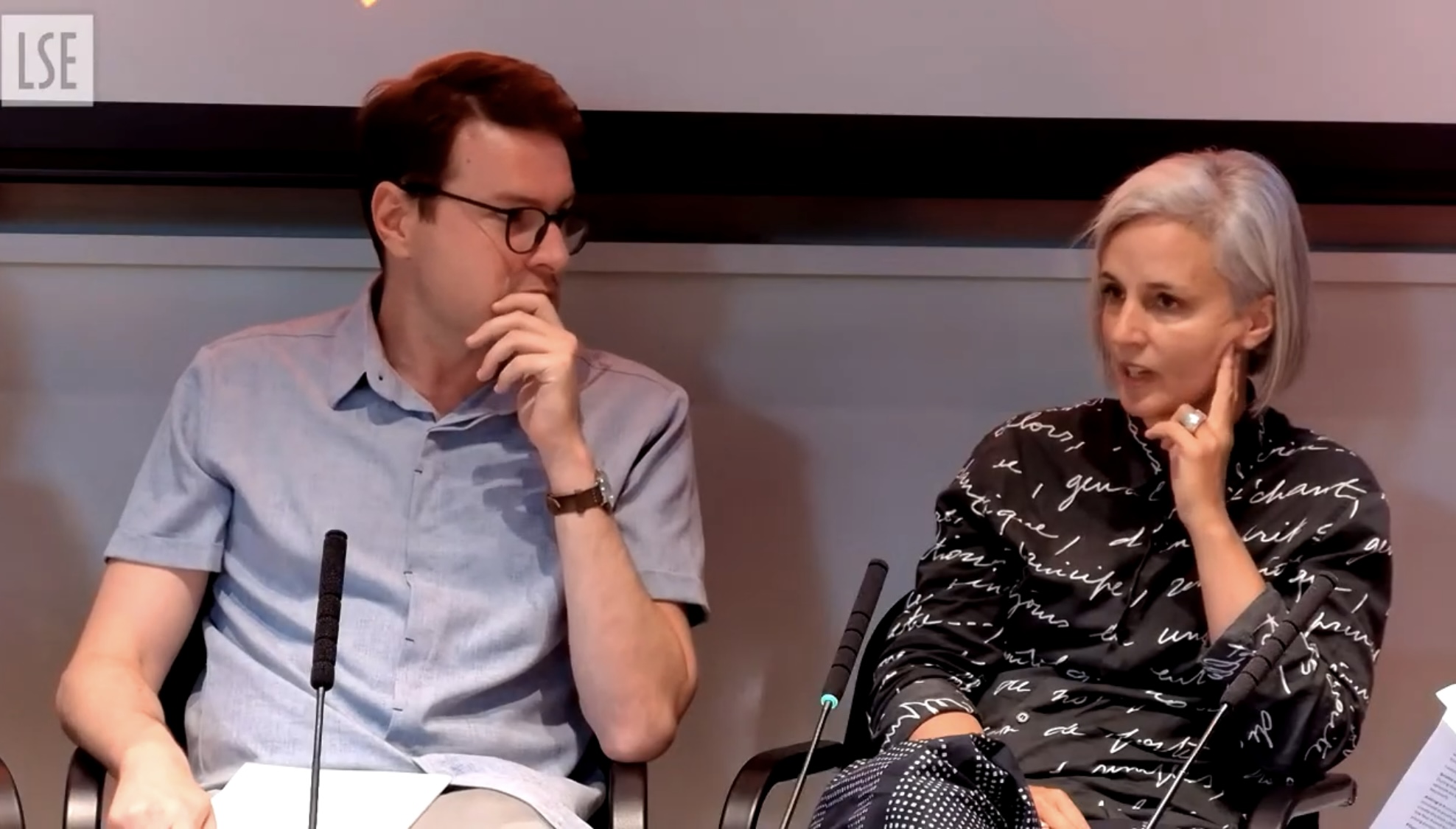
What is a Digital Good Society and how do we get there: Exploring Children’s AttitudesTowards Digital Good and Bad through Hybrid Arts Practices.
xmas25 cross media arts 2025, Lisbon Fine Arts Faculty, 16th-18th June 2025
With Richard Nash, Eleanor Dare, Steve Love, Angus Main, John Potter
Children Attitudes Towards Notions of Digital Good Bad.
Webinar Series: Digital Good in Progress, online, 21st May 2025
This presentation will introduce the hybrid art workshops used to explore children’s current relationship to technologies, ideas for how they could be improved, as well as their understanding of digital systems, how they work and who benefits from them.

What Kind Of Digital Society Do We Want To Live In?
With Thomas Enemark Lundtofte
Panel presentation and discussion as part of Thomas’ visiting scholarship, University of Plymouth, 1st May 2025.
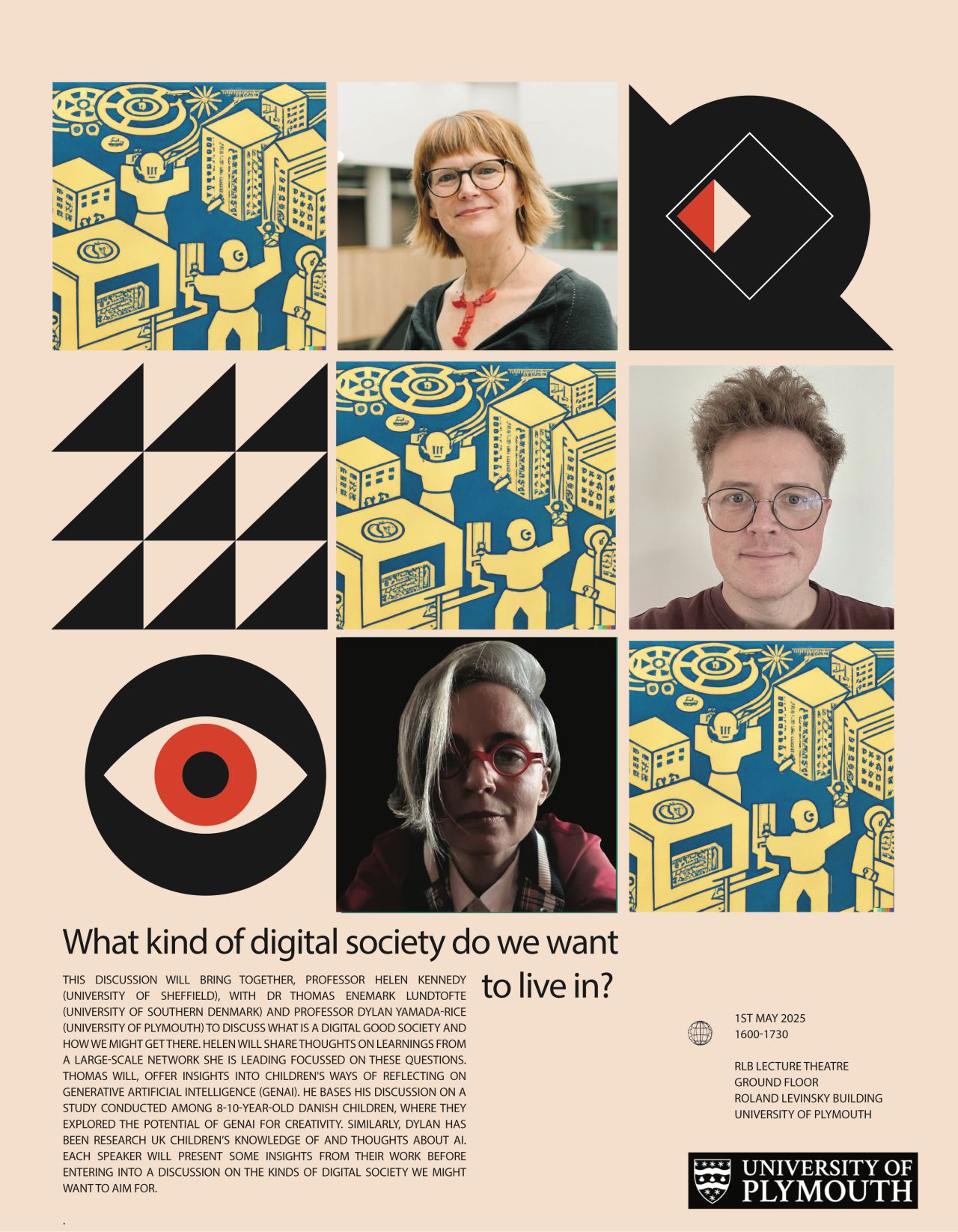
Exploring Children’s Attitudes Towards Notions of Digital Good/Bad
6th International Conference on Machine Learning and Human-Computer Interaction, Meiji University Ikuta Campus, Kawasaki, Japan, March 4-6, 2025
This presentation presents the findings of having worked with approximately 250 children between the ages of 8 and 11-year-olds in the UK to understand their knowledge of and attitudes towards AI. It builds on the research team’s previous work that taught children about digital sensors, the data they can collect about them and used speculative design to create tools to subvert/block them (Main & Yamada-Rice, 2022). The findings that will be presented here are part of a project that more broadly sought children’s attitudes towards notions of digital good/bad and knowledge of how these may differ from adults. The project which was funded by the Economic and Social Research Council used hybrid arts practices to ask “What should a good digital society look like and how do we get there?”, by focusing specifically on children as currently overlooked users of digital technology and emerging digital citizens. Using theories from Kress (2012; 1996), Barad, (2007), Nail (2020) and practices relating to ethical implications of digital, and emerging technologies, this presentation answers this question in relation to the project findings about AI and as such contributes to the MLHMI 2025 conference’s desire to include ethnographic studies on human computer interaction.
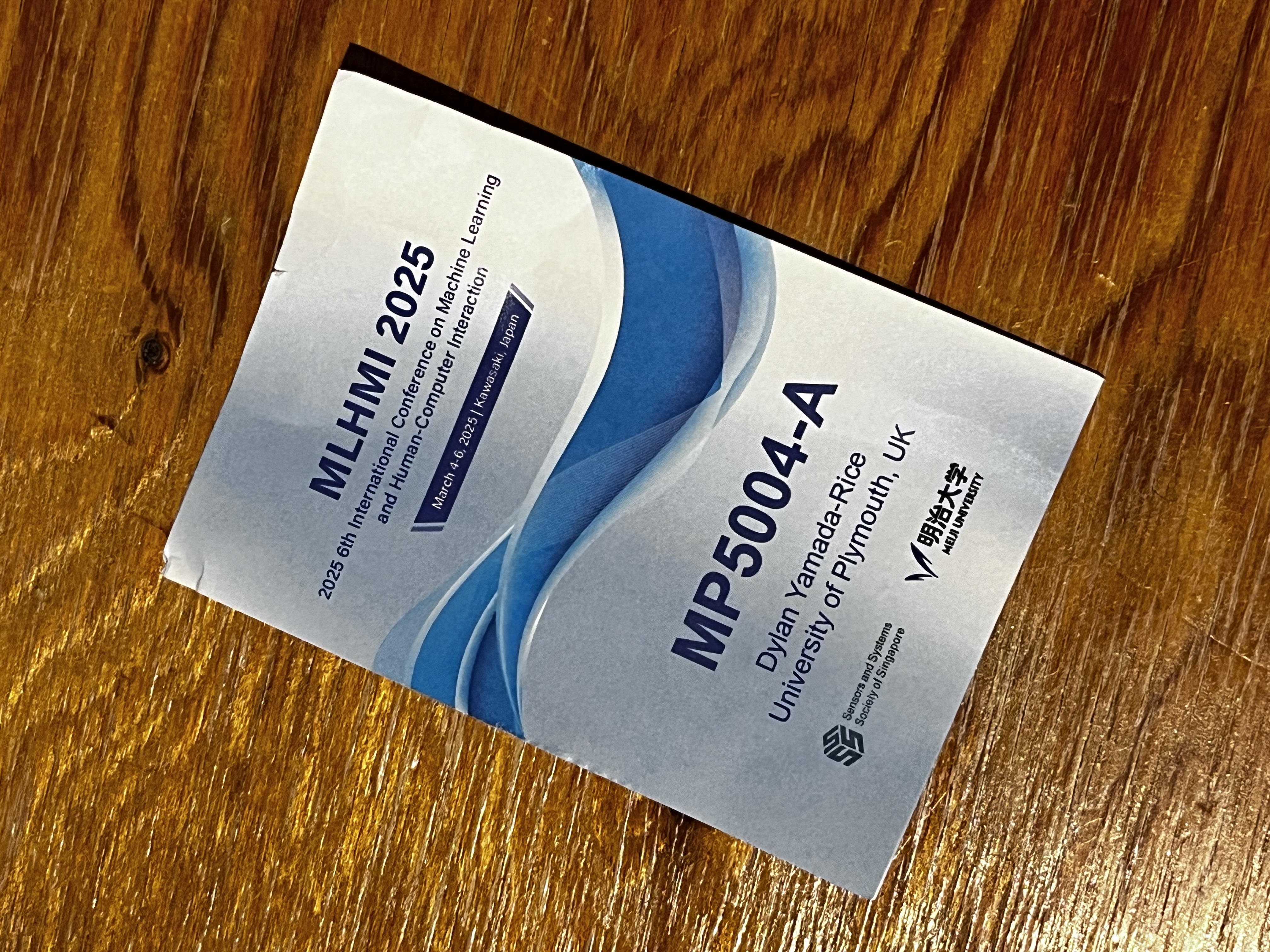
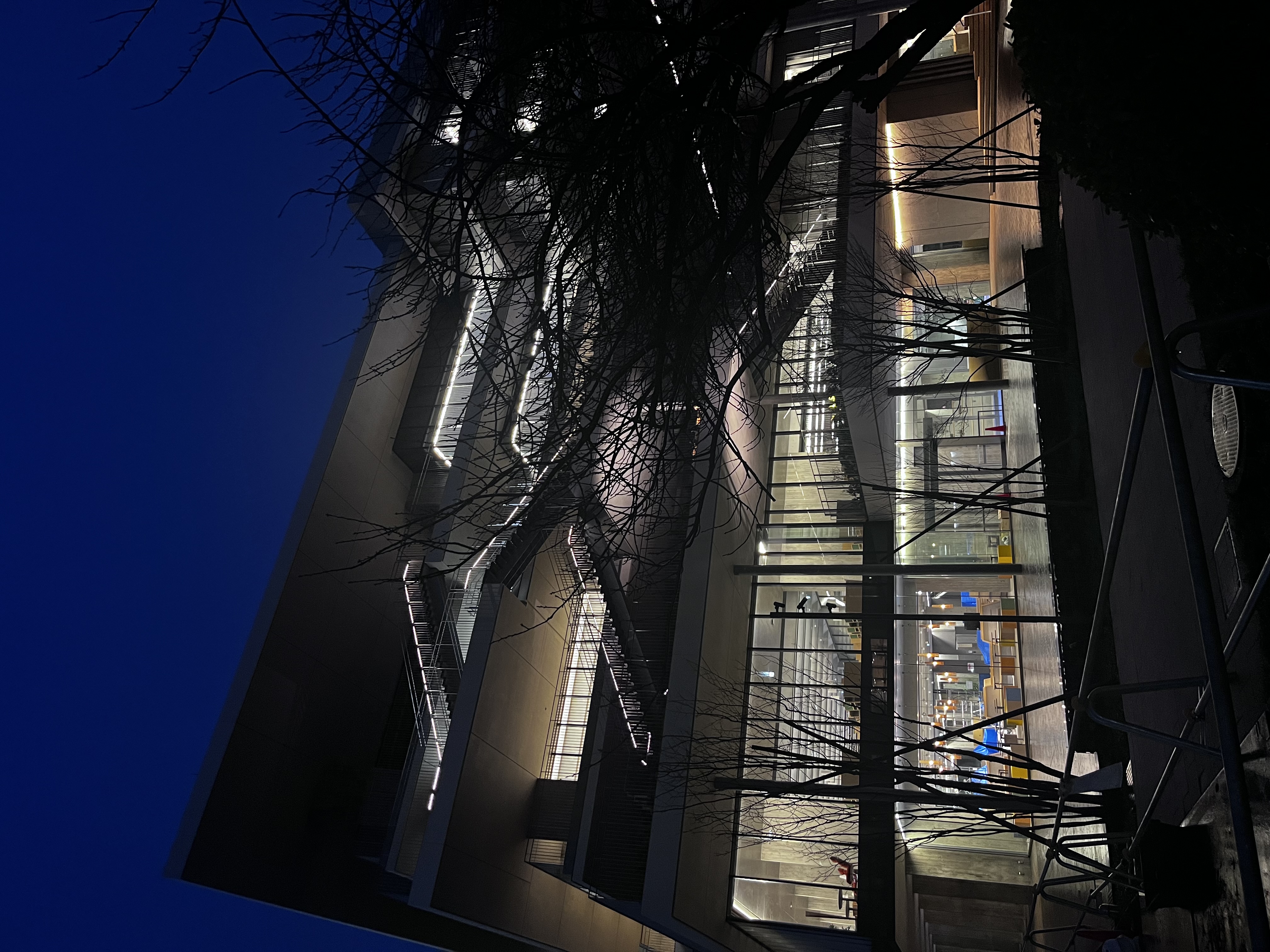
2024
AATE/ALEA National Conference 2024, Adelaide 10-13th July, 2024. Invited Presenter.
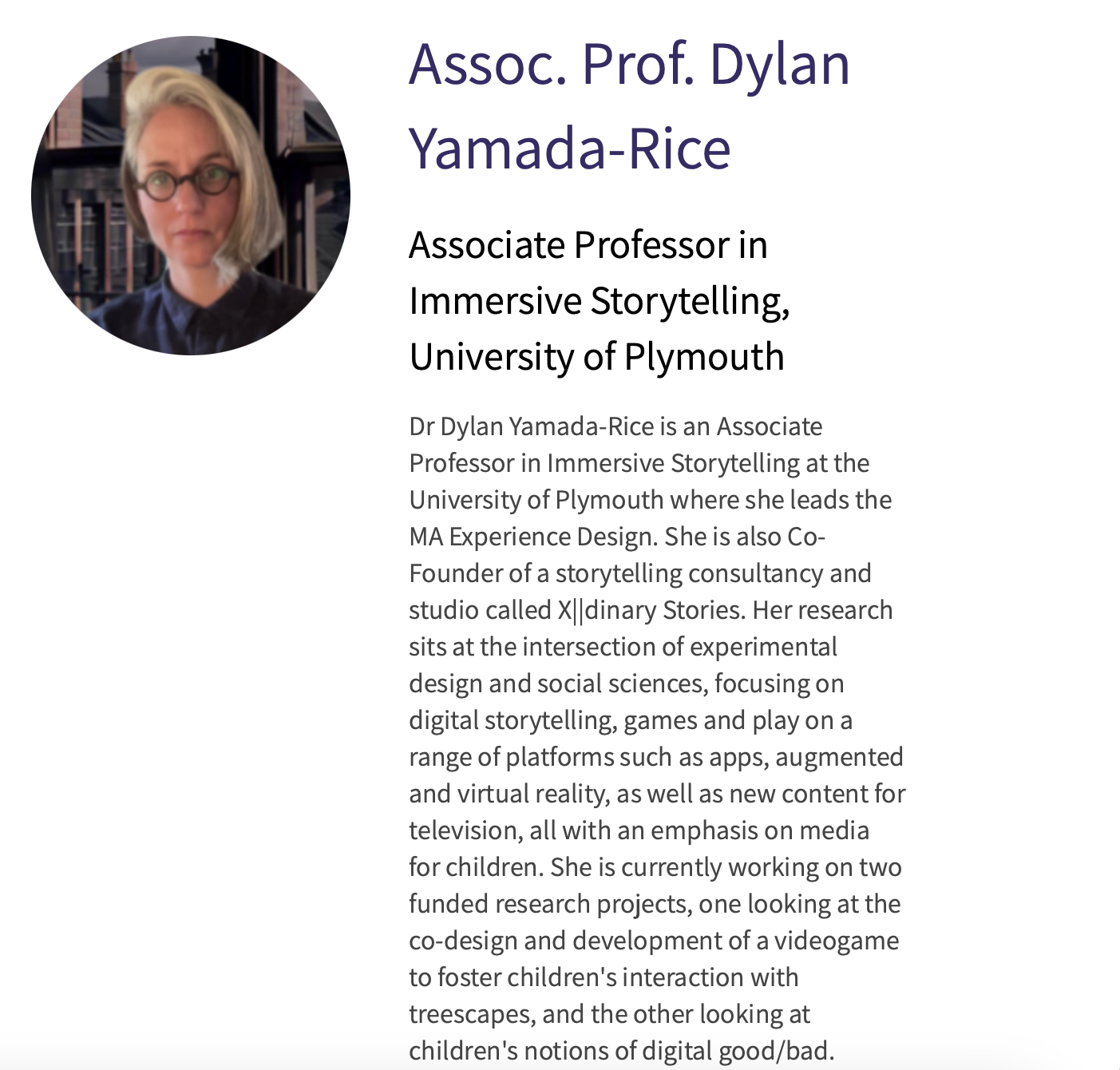
Accidents, games and jokes : engaging [critically] with emerging and older technologies for entangled storytelling/playing
with Eleanor Dare
Entangled Futures, University of Cambridge, St John's College, 7th June 2024
Dylan Yamada-Rice and Eleanor Dare are the co-founders of X||dinary Stories, a creative studio focused on telling stories with ancient and emerging technologies. Together and separately they have been evolving situated and embodied responses to emerging and older technologies for the last several years, in their capacity as artist researchers, academics and developers of performances, games and workshops. For this session they will discuss the importance of Design Justice, speculative and worldbuilding approaches which allow for a greater scope of practices then technologically determined constructs of 'innovation' and 'disruption' appear to allow. They will talk about accidents, Generative AI, games and jokes and the importance of drawing, comics, walking and creating/repurposing toys in the process of developing their work. The session will involve a hands-on engagement with contingent storytelling and a critical grasp of the socio technical structures in which our work emerges, particularly the tensions implicit in a 'technology first' approach, which so often occludes hidden curricula.

Participatory Research with Marginalised Communities: Ethics, Design and Co-Production
Webinar for the ESRC Digital Good Network, 3rd June 2024

Including Children in Research
University of Southern Denmark, 29th May 2024
Development and introduction of a mixed realities playkit: decreasing the incidence of general anaesthesia for paediatric MRI
with Jill Thompson, Louise Murray, Sean Thompson and Matthew Taylor
APAGBI (Association of Paediatric Anaesthetists of Great Britain and Ireland) conference in Newcastle, 20-21st May 2024
Creating Cultural Probes to Include Children in the Design of Health Interventions
Do Well, MMU, 13th March 2024
Bodies & Machines
Bite sized talk with Angela Picinni to accompany the show ‘Resonating Bodies’ by Karen Abadie and Laura Rosser, 7th February 2024



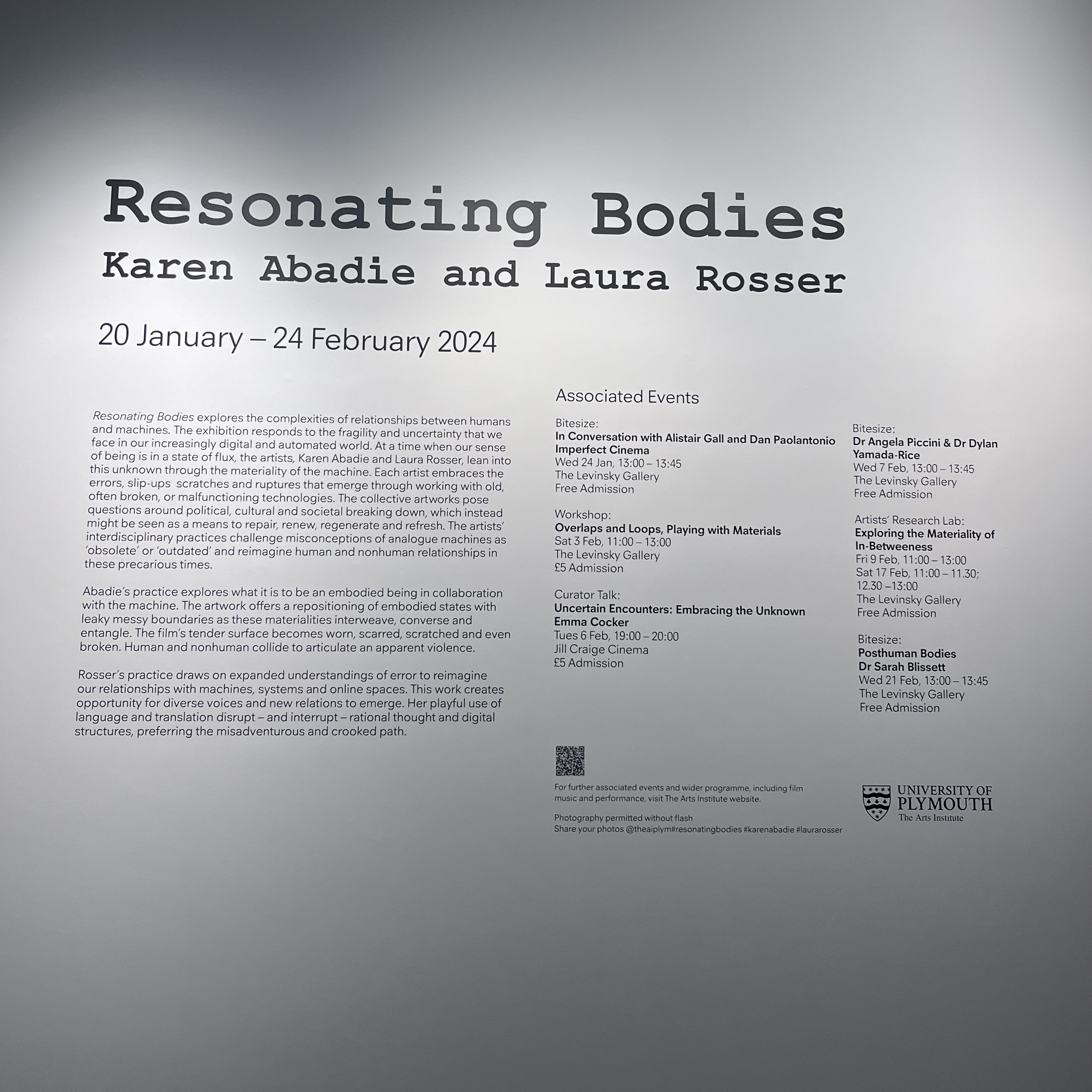
Kids Notions of Digital Good Bad
Digital Good Network - January Showcase 2024, The Wave, University of Sheffield, 18th- 19th January 2024
With John Potter
2023
Evolve-It
Plymouth Undokai, University of Plymouth, 24th November 2023

The Future of Broadcast Media According to Kids
4th European Alliance for Innovation (EAI) International Conference on Technology, Innovation, Entrepreneaurship and Education, Magdalene College, 28th September 2023
With Eleanor Dare

Mixed realities play kit to prepare children to undertake an MRI
Do Well: Design for Health and Wellbeing symposium, Manchester Met Uni, 17th May 2023

The Future of Broadcast Media According to Kids
The Future is Northern, The Studio, Leeds, 28th March 2023
With Eleanor Dare
In this presentation we shared the experiemental methodology and findings of a project commissioned by the University of York’s XR Stories to explore what children want from future broadcast media. The project explored what children under 11-years-old think is the future of broadcasting. Our project was framed within the decline of children watching linear TV and the rise of various
fields such as filmmaking, theatre and gaming and seeking to find new ways of reaching audiences with emerging technologies.
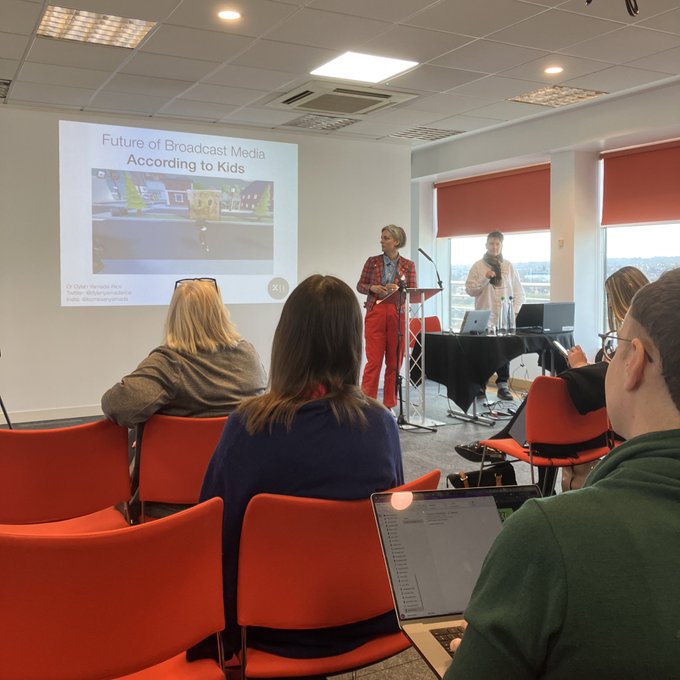
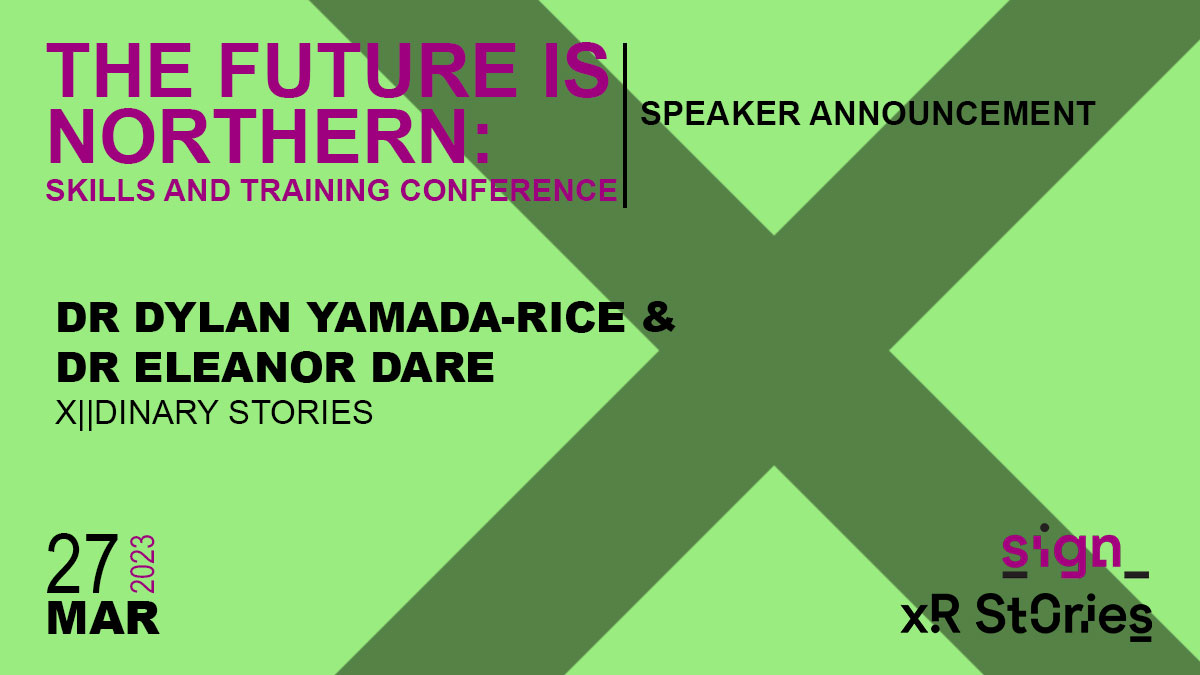
Storytelling in a Digital Age: how immersive entertainment can support childhood development
NESTA, 23rd Feburary 2023
From Teletubbies to Fortnite, the way children consume content has changed forever. What can the creative industries learn from the way children watch, listen and play in the new digital age and how might this understanding help the sector better support childhood development?
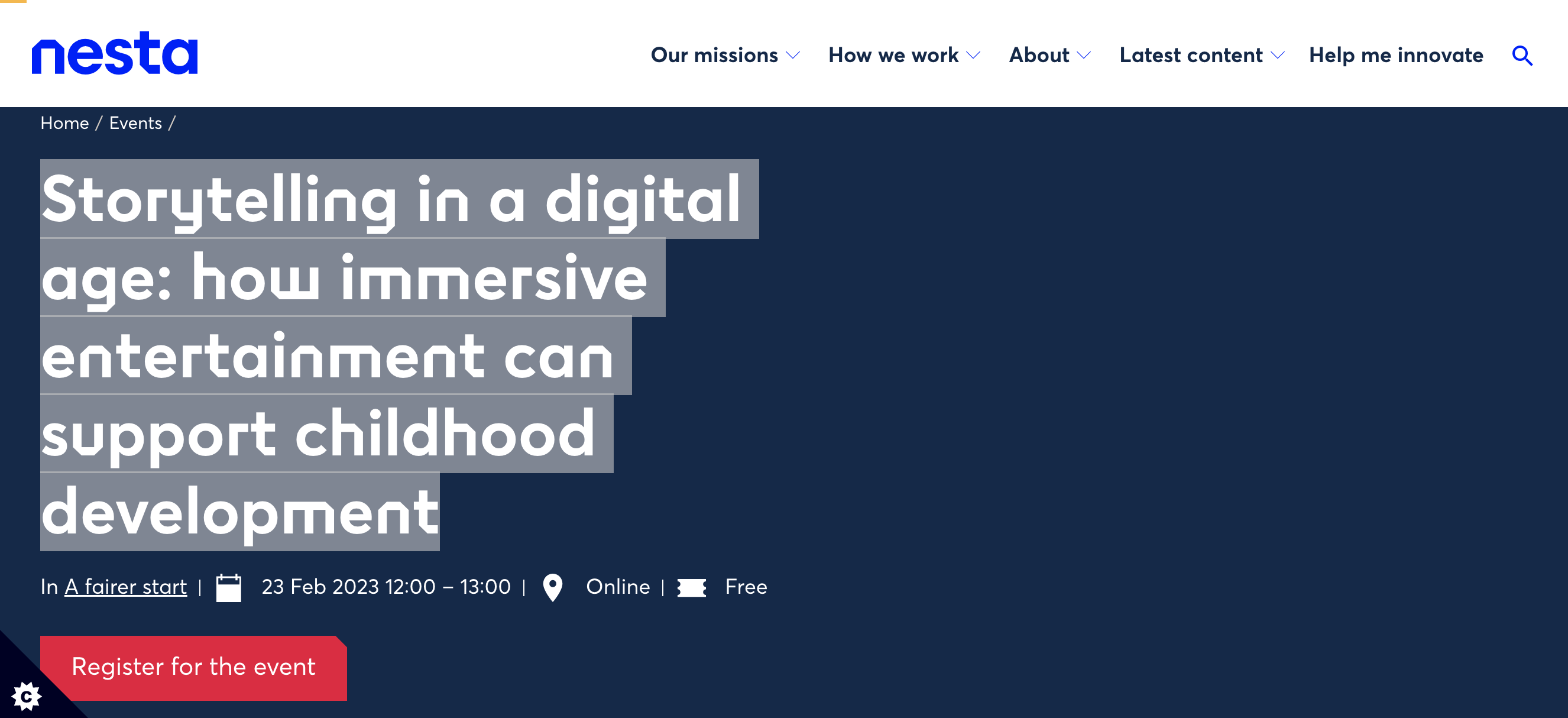

A visionary look at how the metaverse could change research and insights practices in the near future
Insights from the Metaverse 2023, Market Research Society, 20th January 2023
Brands are starting to focus on integrating their IPs into multiple digital worlds and implementing multi-game engagement strategies. This thought piece focused on where research fits and how we ensure best ethical practices. It encouraged the audience to explore exciting possibilities for gaining deep insights into users’ lives in novel ways, looking at how the metaverse can be used to create new spaces for qualitative research.
It considered hybrid methodologies that combine digital design and play with traditional qualitative techniques to more fully engage young people in research processes. It examined best practices fo creating metaverse platform content for children and young people that can be applied in conducting research.

2022
Immersive Storytelling in the Context of Child Health
Invited talk for the Education and Social Research Institute, MMU, 7th December 2022
Critical Chatbots, Tarrot and Drawing as an Epistomological Repositioning to Defend aganst the Neoliberal Structures of Art Education
with Eleanor Dare, ELIA, Helsinki, 25th November 2022


Games & Play to Engage Research Participants in Projects about Change
Invited talk for Manchester Centre for Youth Studies, online, 26th October 2022
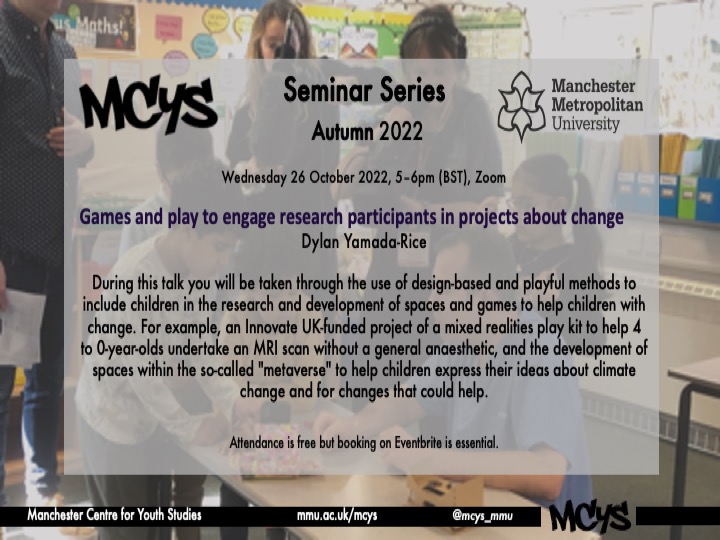
Village Green Talks, MMU, 12th October 2022
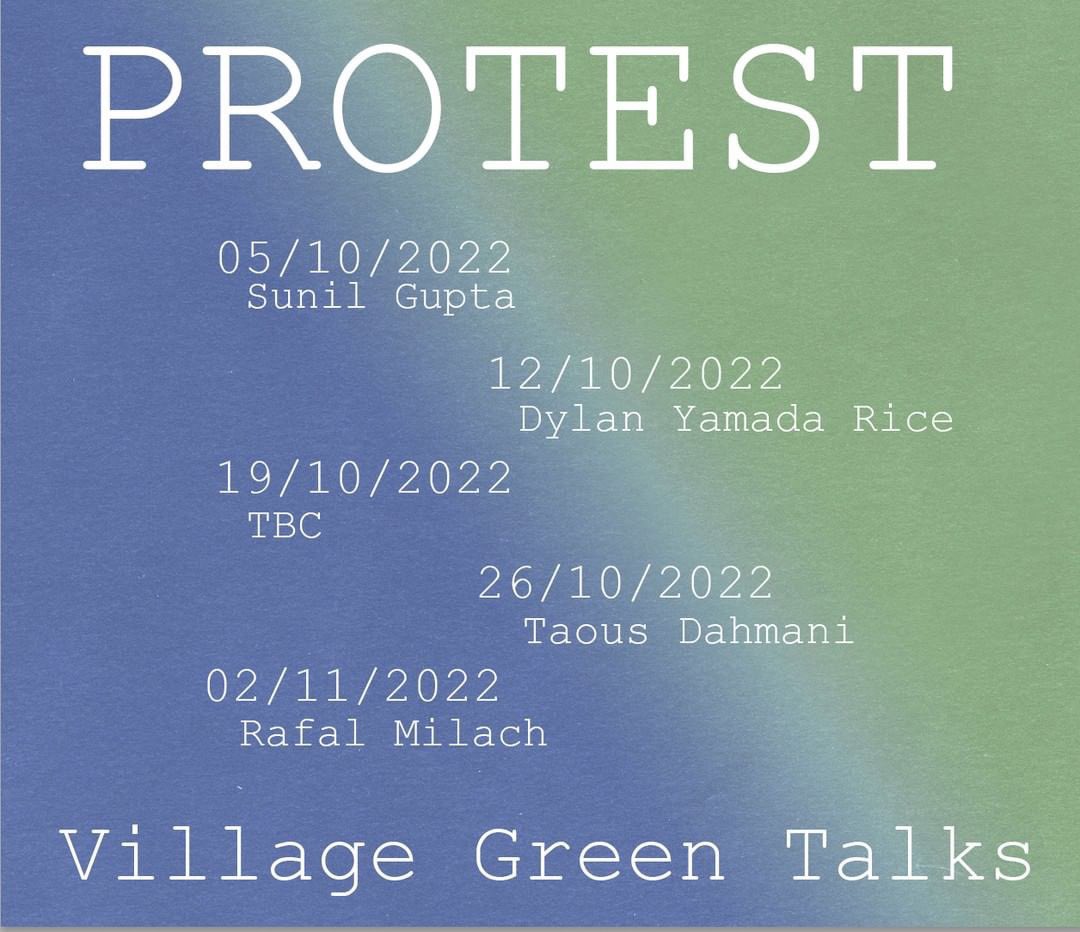
Games for Change, New York City, 13-16 July 2022, Keynote
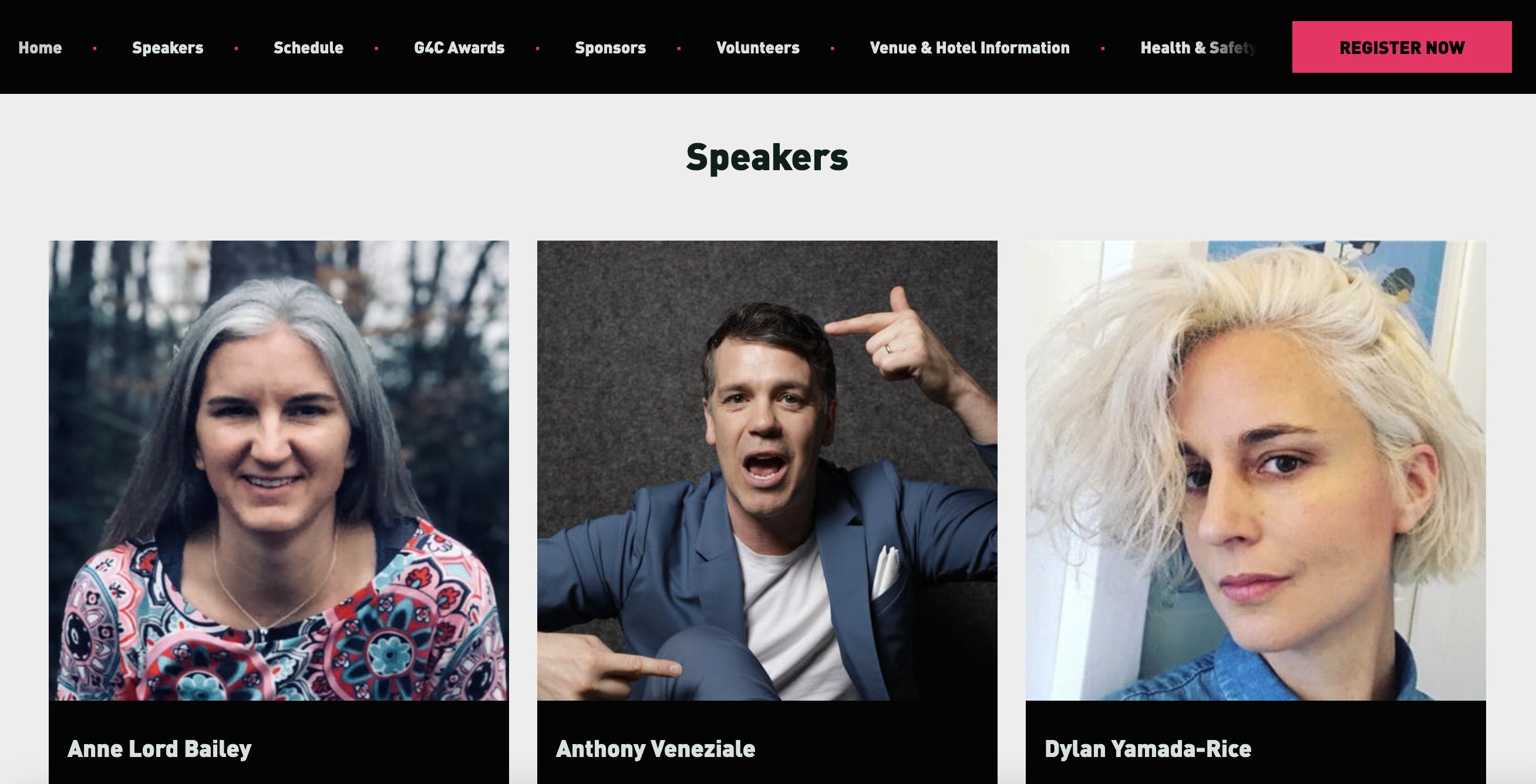

In this you are taken through the use of design-based and playful methods to include children in the research and development of an innovative XR playkit to help 4 to 10-year-olds undertake an MRI scan without a general anaesthetic. On the way, you will be asked to consider the other contexts in which learning through play can be helpful to children.
Equity and the Immersive Lab: Polygon by polygon, how do we build an equitable world?
with Eleanor Dare
Kingston University 22nd June 2022, Keynote
Augmenting Personal Creativity with Artificial Intelligence
Angus Main, Mick Grierson, Dylan Yamada-Rice, Joshua MurrCreativity& Cognition, Venice, 20th June 2022, Full-day Workshop
Website: http://www.augmentingcreativity.info/
This research workshop focuses on emerging approaches for using Artificial Intelligence (AI) systems to support and augment personal creativity. Recent developments in generative Machine Learning demonstrate the ability of AI systems to perform tasks which are often associated with creativity – generating imagery, composing music, writing prose, etc. This workshop will examine opportunities for incorporating this kind of functionality into the creative practice of designers, artists and craftspeople, in practical and experimental ways. It will focus on how AI might enhance, rather than supplant, individual human creativity, through collaboration, serendipity, and creative reflection. We seek to engage a broad range of creative practitioners and researchers, bringing together those already using AI in their practice with those who are new to the technology, to understand emerging approaches and define future opportunities.
The Art of Storytelling
The Richmond Market Insight Forum, Savoy Place, London, 8th June 2022
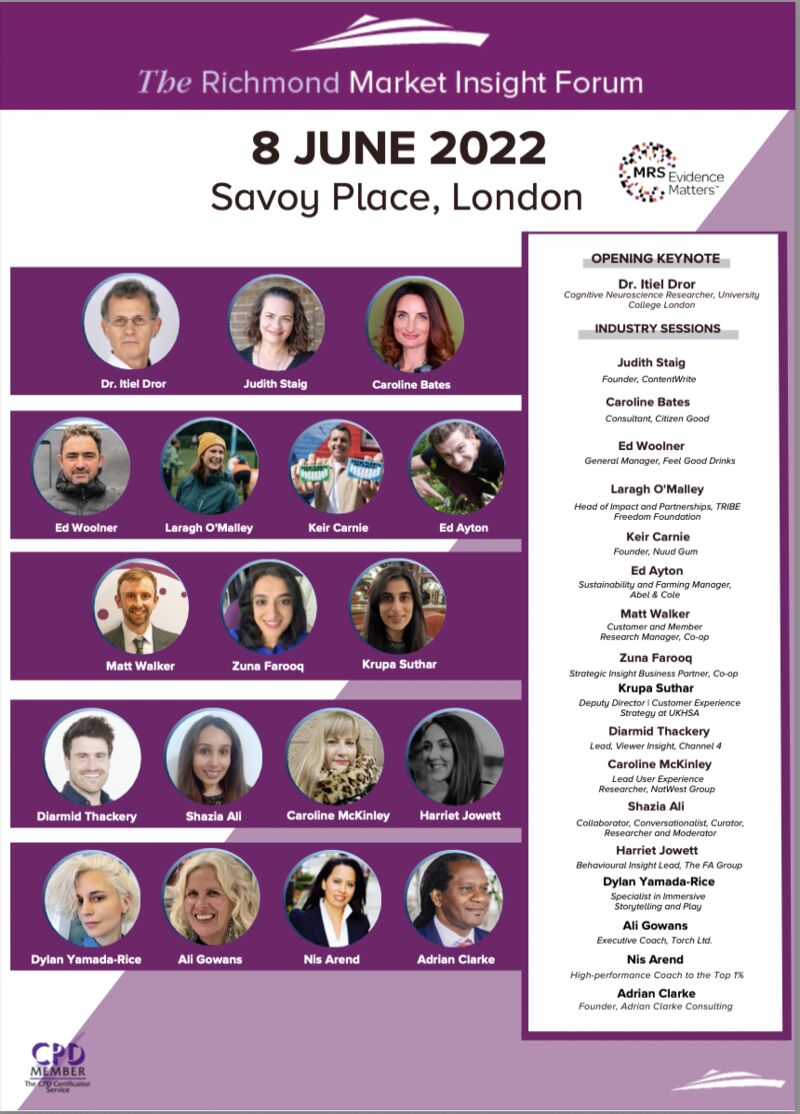
Invited presentation for Western Cape Education Department’s Empower Hour, South Africa, 20th May 2022
Re-imaging Data Storytelling and its Impact will show you the expansive and imaginative ways in which data can be achieved through online and offline possibilities. It will demonstrate powerful ways in which we can reimagine the use and impact of data storytelling. It will provide key insight on how to analyze and engage with data in order to make sound data-driven decisions and how to convey data in a creative way. This session will awaken our minds to the concept of play in data and change any daunting perspectives we may have of DATA.
The Empower Hour aims to create a platform for discussion, learning, connecting, expanding and building on our educational and eLearning knowledge. It seeks to activate collegial support and learning together. It seeks to strengthen metacognition and hone mindfulness. It aims to support, challenge and build on constructive critical reflections. This is an open invitation for learning.

Co-designing a Mixed Realities Playkit to prepare Children for an MRI Scan without a General Anesthetic
with Jill Thompson, NHIR 11th May 2022
This paper focuses on using design-based and playful methods to include children in the development of MedTech. This is done in relation to our Innovate UK funded R&D of an innovative mixed realities (virtual and augmented) playkit to help 4-10-year-olds undertake an MRI scan without a GA. The project team included researchers and developers from Dubit (a company specialising R&D of children’s digital products), Sheffield Children’s Hospital NHS Trust, the University of Sheffield and the Glasgow School of Art.
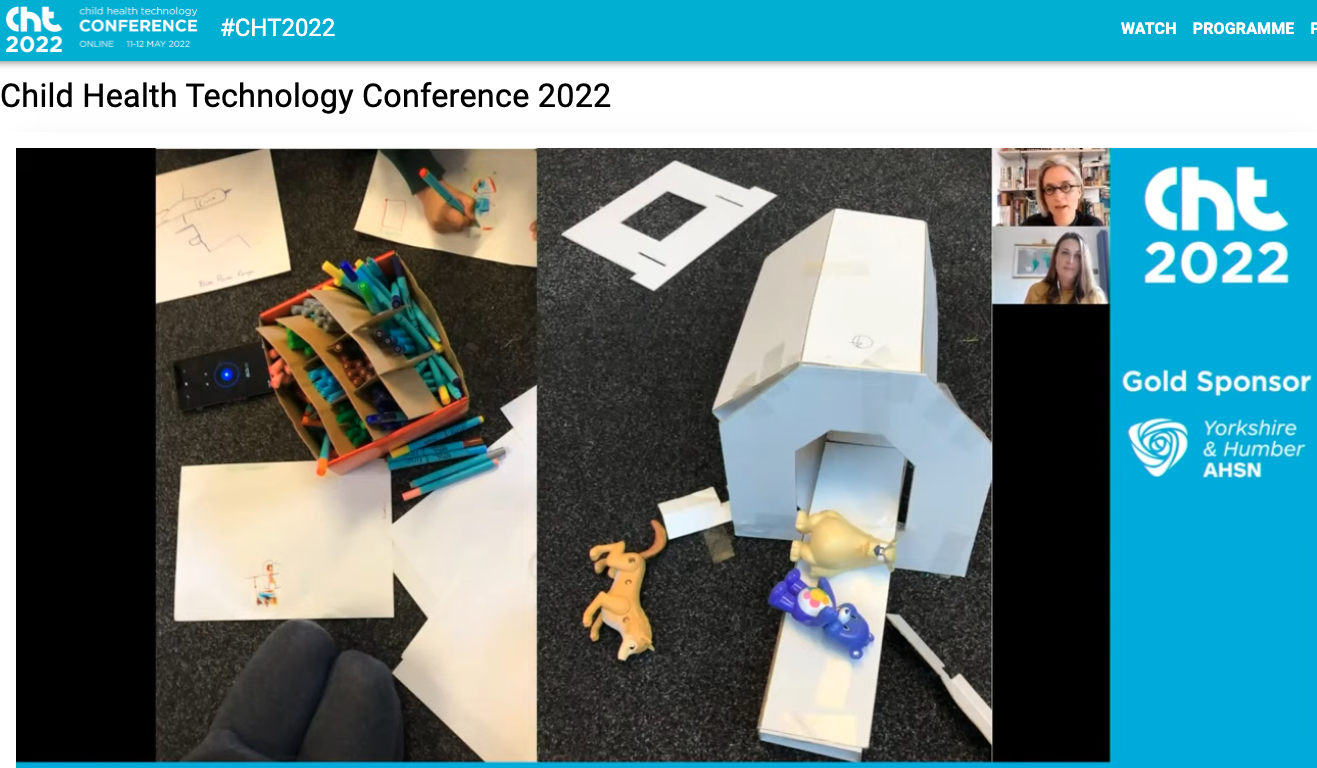
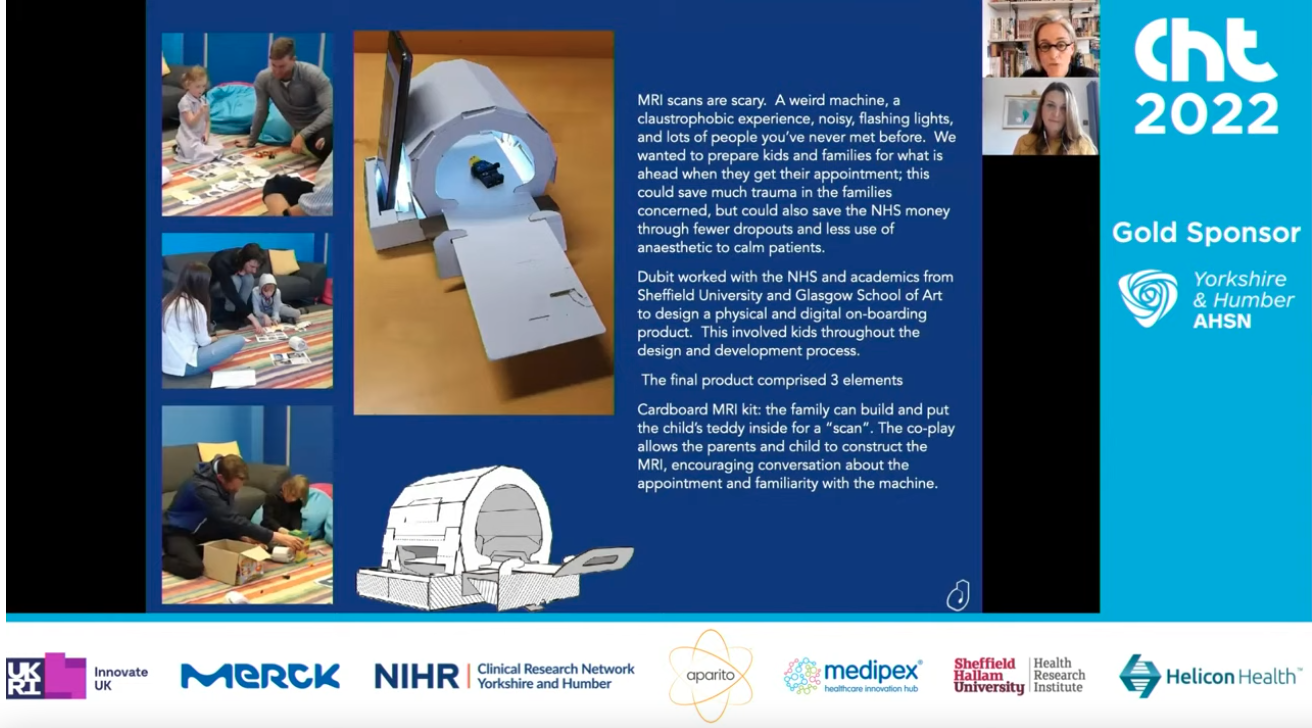
We aim to present innovative methods from games design that were used to include children directly in the project’s R&D, and how these facilitated understanding elements fundamental to the successful uptake of medtech used in the preparation of children for medical procedures and treatments. The 30-month project included methods of co-design and production that used drawing, model-making, user testing, and character design. We will discuss the benefits of including children in the design of health products and interventions and the means used to analyse the outputs of design-based methods. As well as, how these outcomes were implemented into the development phases via design summits that included hospital specialists, games designers, and academics. Our findings show that when children are the end users of medical products their input is vital to the success of what is produced.
Discussuon is centred on how these methods led us to understand that the ways in which children make sense of medical information and procedures is fundamentally different from adults. In particular, children’s desire for medtech that is playful, has spaces for open-ended play and storytelling to exist alongside the dissemination of medical information.
Socially-Distanced Games and Play as a means of Remote Data Collection
Remote Sensing, University of the Arts, London 29th April 2022
This talk will provide details of how digital games and play can be used to engage research participants remotely. Specifically, I will share glimpses into some of the methods used on three projects that took place during lock-down. The first was the development of a videogame (see image above) that was used to collect quantitative data from young children about their sleep habits. The work was connected to a theatre performance called Sweet Dreams by tutti frutti. Originally, the work was scheduled to be a live theatre performance with a hands-on interactive mechanism for undertaking research with children. When the pandemic hit the play became a series of podcasts and the research methods were developed to the newly remote nature of the audience. Secondly, I will show how the co-production of a round-robin artists Zine allowed for deeper analysis of collective data, while also acting as an immersive storytelling practice.Lastly, the audience will be introduced to a project that undertook speculative design research with children remotely to create tools that could either block or subvert digital sensors embedded in their everyday devices.

(Remote Sensing)
Bunker Talks
Manchester School of Art, broadcast online.
April 2022
![]()
![]()
![]()
Virtual magic: sleight of hand in immersive storytelling
Invited Keynote with Eleanor Dare, Connecting Screens: Playing with Immersive Systems Research Symposium, Leeds School of Art, 30th March 2022
The role of techniques from illusion and magic in creating effective content for a range of media is increasingly recognised by cognitive neuroscientists and behavioural psychologists (Quian Quiroga, 2016). It is no surprise, therefore, that the same techniques are also effective for optimising virtual stories. Eleanor and I outlined two interlinked projects that sought to offer insight into alternative frameworks for building virtual story worlds. For Eleanor this was in relation to queer theory which she used in the development of Queer Psycho and for me this was technigues from magic and more than human theory which I used in the development of the a virtual world in Roblox called HE Circus.
Designing with Children: How to Involve them in Research
Digital Kids Today, Aarhaus, Denmark, Invited Keynote, 3rd March 2022
![]()
![]()
![]()
![]()
![]()
![]()
![]()
![]()
Dismantle the Doors: approaches to interdisciplinary research and practice
Jill Craigie Cinema, Roland Levinsky Building, University of Plymouth, 24th Feburary 2022
Invited keynote speaker for i-Dat Visitng Lecturers and given as part of the University of Plymouth’s Professional And Creative Attributes Week. Talking research and practice with Rifke Sadleir (Co-director of art direction and digital development agency).
In this talk I introduced my work in research and design of stories and play. Through a whistle stop tour of some recent projects, I showed how experimental methods and interdisciplinary approaches are at the heart of my work. Such as, by combining social science research methods with art and design practices throughout the design and development processes. This included work on the CBBC show “Moon and Me”, a mixed realities playkit to prepare children for an MRI scan, a VR experience made for the Young V&A and a series of experimental data collecting experience machines used by theatre companies and galleries.
I invited the audience to think about how my motto: “Collaborate or Die” could be used to imagine alternate futures, both in the ways in which we undertake research and design but also in prioritising what should be at the heart of our practice right now.
Manchester School of Art, broadcast online.
April 2022
Virtual magic: sleight of hand in immersive storytelling
Invited Keynote with Eleanor Dare, Connecting Screens: Playing with Immersive Systems Research Symposium, Leeds School of Art, 30th March 2022
The role of techniques from illusion and magic in creating effective content for a range of media is increasingly recognised by cognitive neuroscientists and behavioural psychologists (Quian Quiroga, 2016). It is no surprise, therefore, that the same techniques are also effective for optimising virtual stories. Eleanor and I outlined two interlinked projects that sought to offer insight into alternative frameworks for building virtual story worlds. For Eleanor this was in relation to queer theory which she used in the development of Queer Psycho and for me this was technigues from magic and more than human theory which I used in the development of the a virtual world in Roblox called HE Circus.
Designing with Children: How to Involve them in Research
Digital Kids Today, Aarhaus, Denmark, Invited Keynote, 3rd March 2022
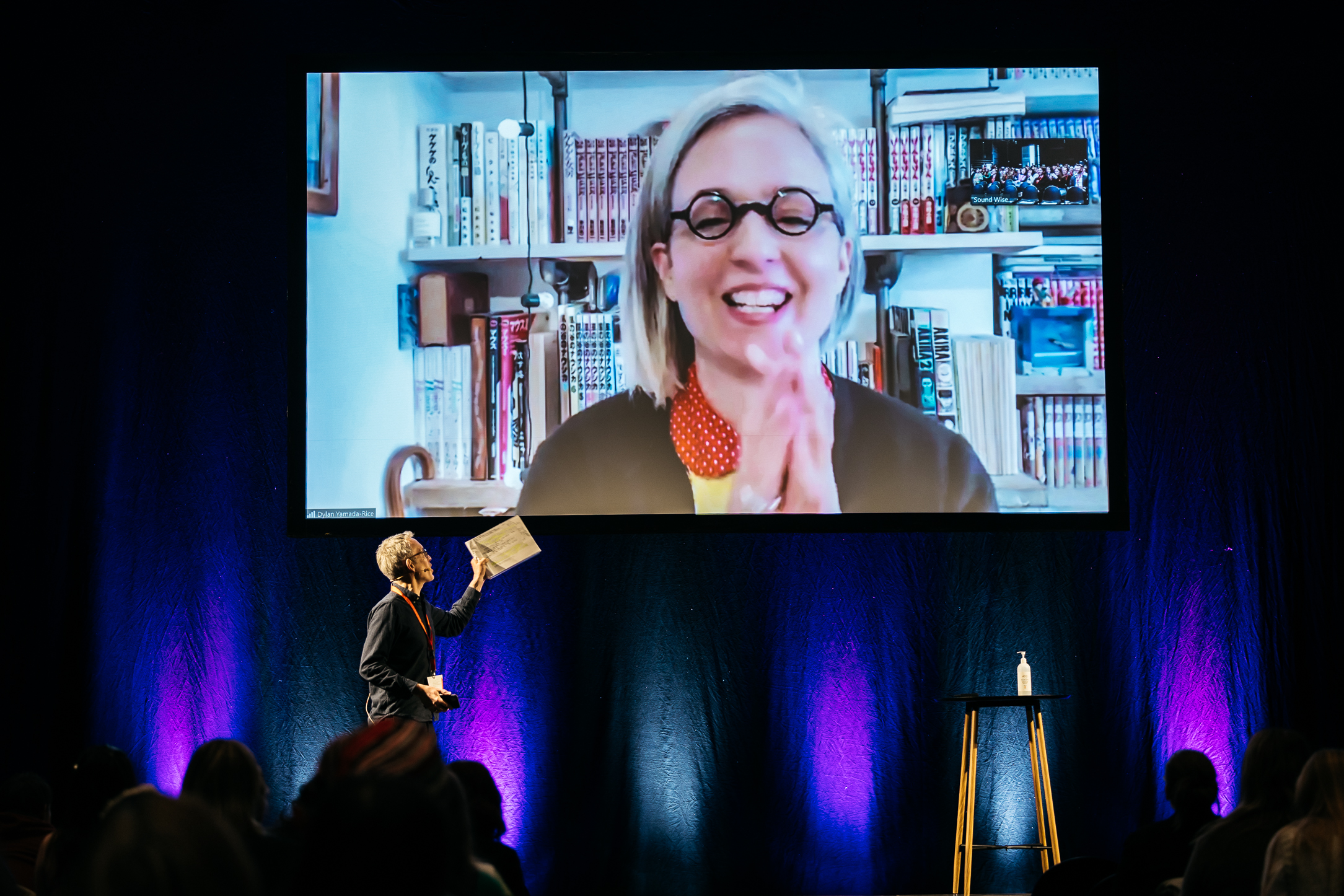

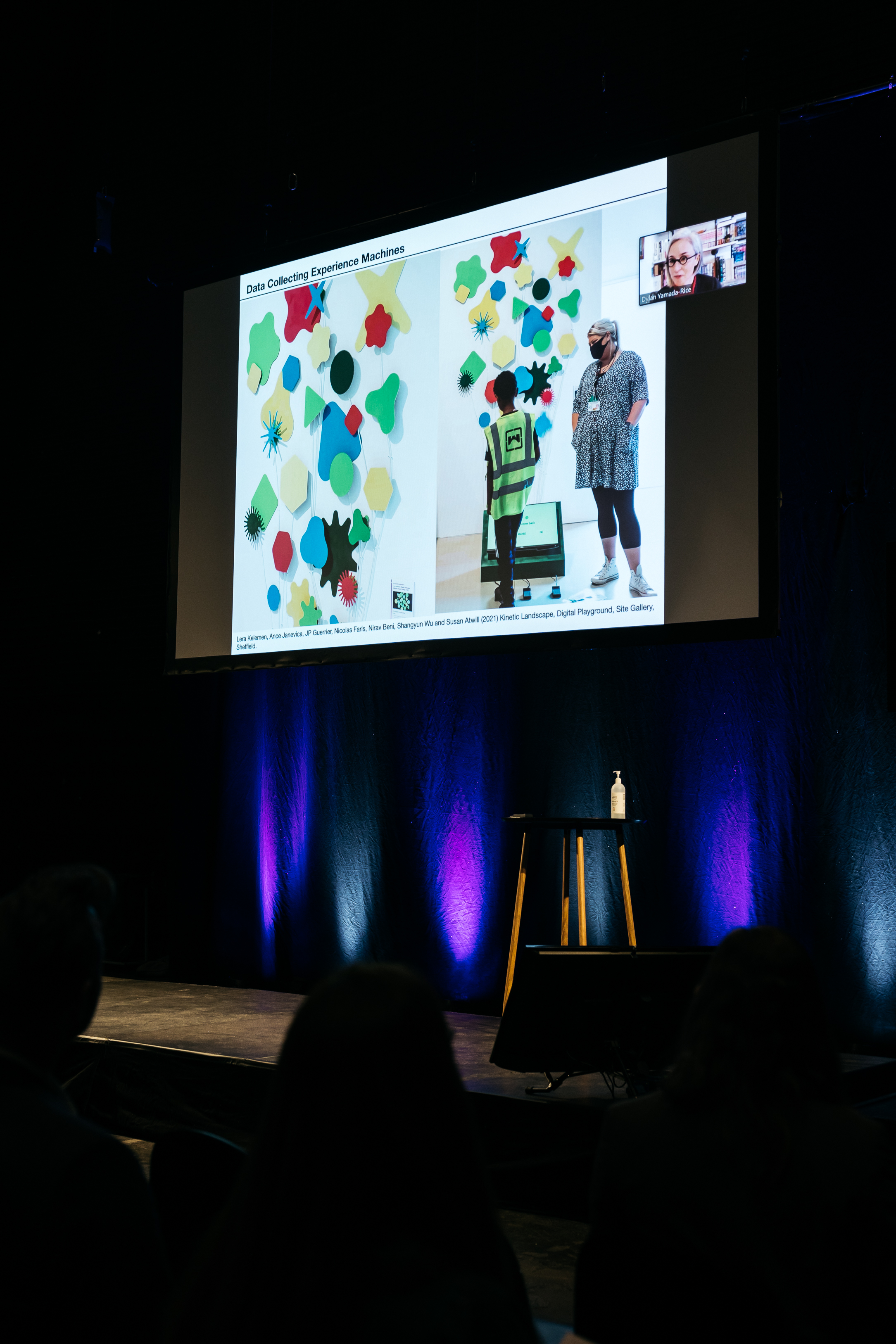
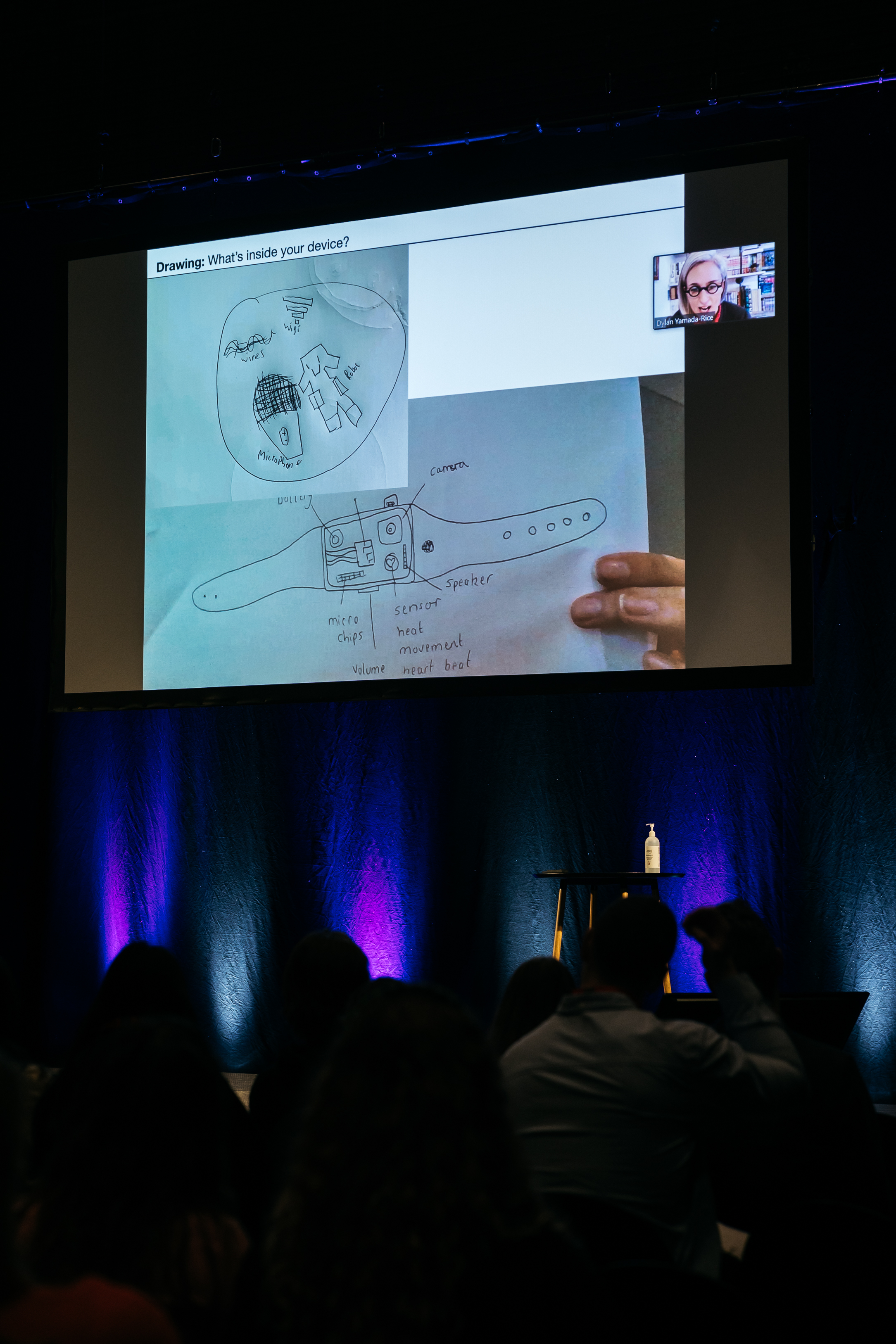

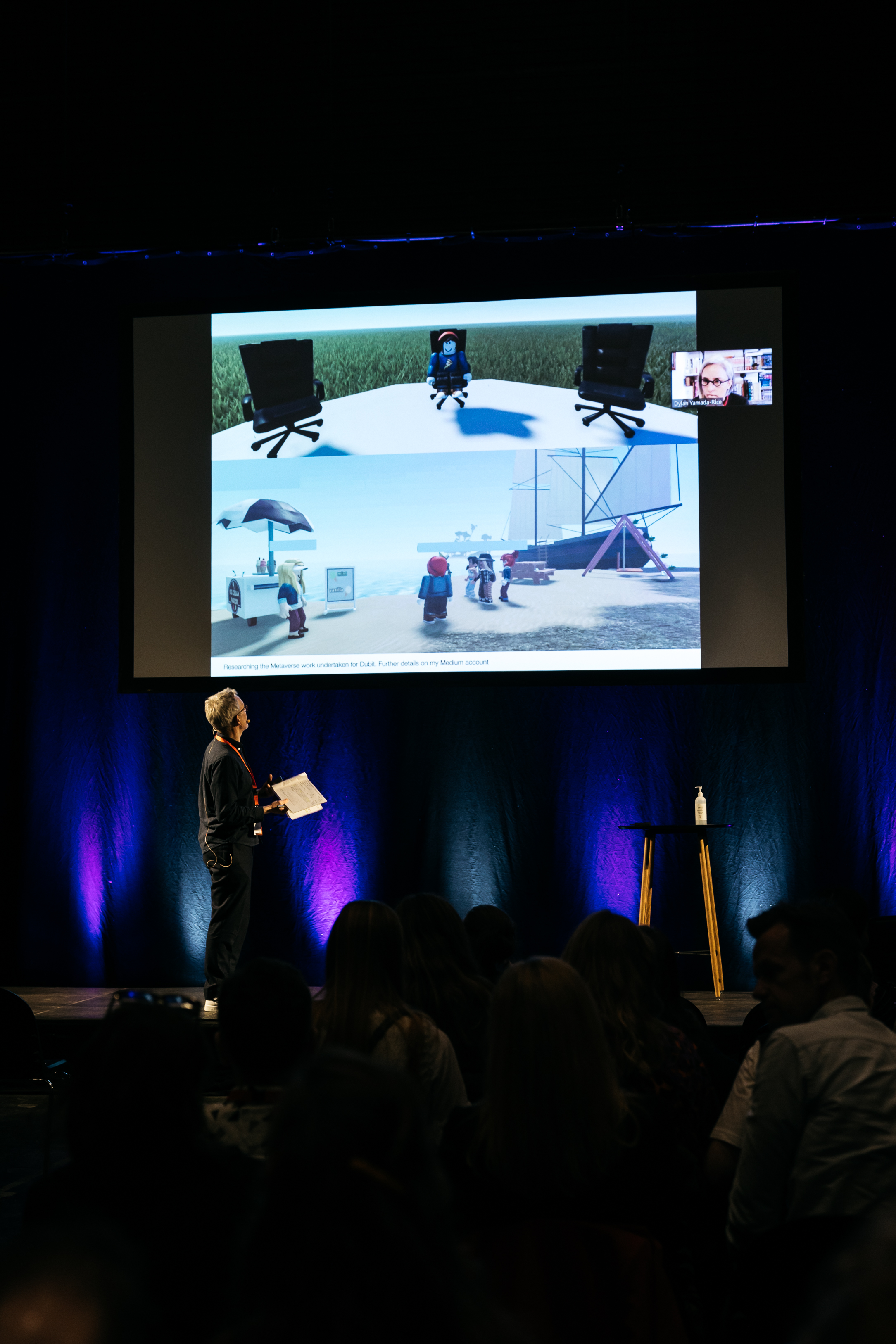
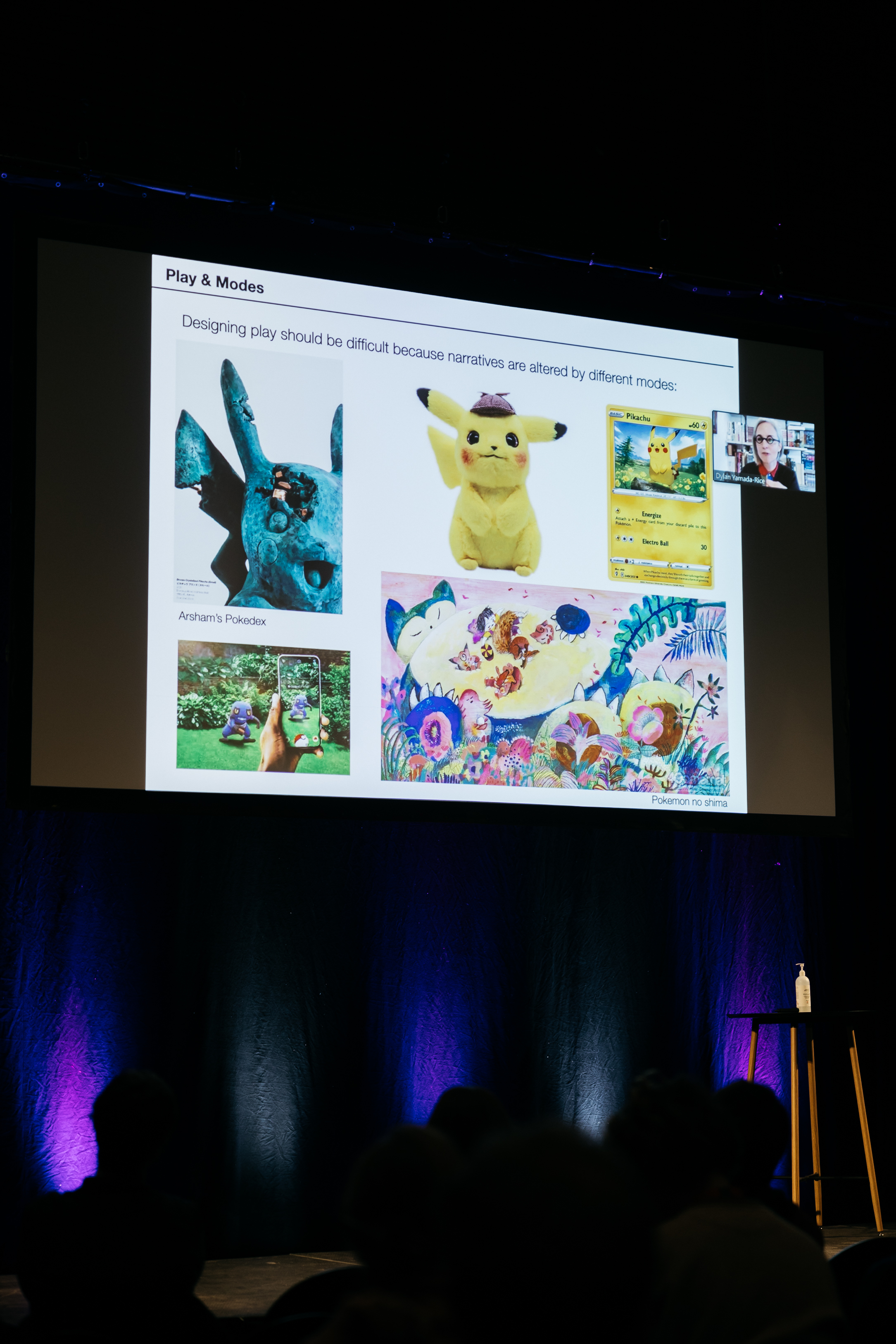
Dismantle the Doors: approaches to interdisciplinary research and practice
Jill Craigie Cinema, Roland Levinsky Building, University of Plymouth, 24th Feburary 2022
Invited keynote speaker for i-Dat Visitng Lecturers and given as part of the University of Plymouth’s Professional And Creative Attributes Week. Talking research and practice with Rifke Sadleir (Co-director of art direction and digital development agency).
In this talk I introduced my work in research and design of stories and play. Through a whistle stop tour of some recent projects, I showed how experimental methods and interdisciplinary approaches are at the heart of my work. Such as, by combining social science research methods with art and design practices throughout the design and development processes. This included work on the CBBC show “Moon and Me”, a mixed realities playkit to prepare children for an MRI scan, a VR experience made for the Young V&A and a series of experimental data collecting experience machines used by theatre companies and galleries.
I invited the audience to think about how my motto: “Collaborate or Die” could be used to imagine alternate futures, both in the ways in which we undertake research and design but also in prioritising what should be at the heart of our practice right now.
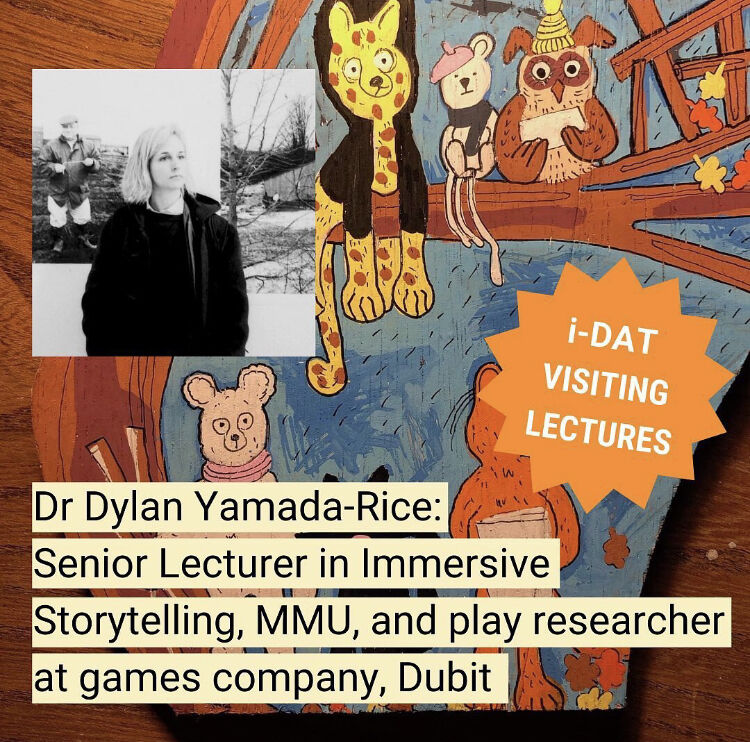
Dismantle the Doors: an interdisciplinary approach to information and experience in the design of play and storytelling Manchester School of Art, 10th Feburary 2022
An in person talk. The first time in forever! ‘Dismantle the Doors’ will look at my approach to collaborate and interdisciplinary practice in the fields of storytelling and play.
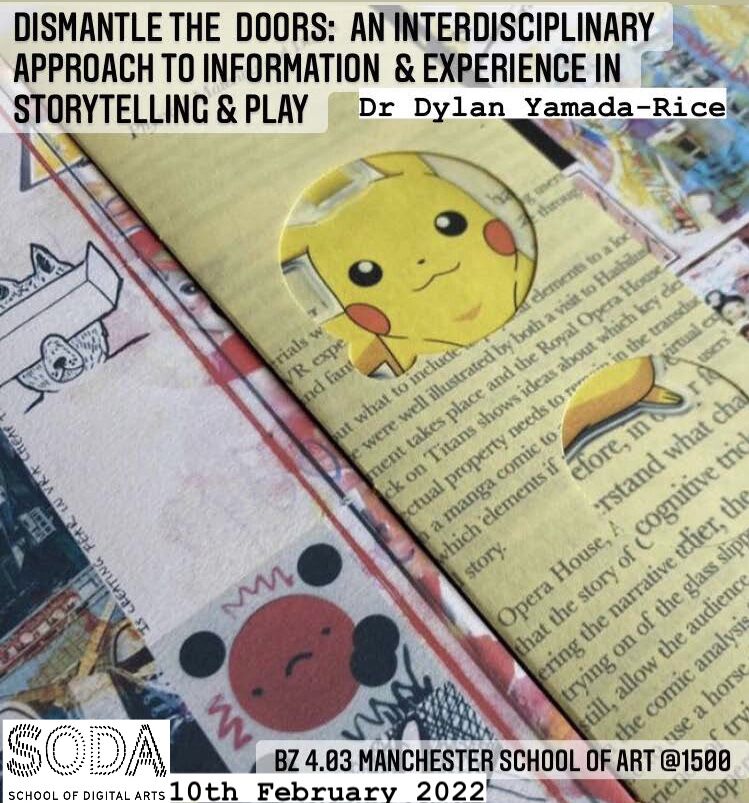
What Matters in Early Childhood Studies Now?
Invited Keynote presentation Brock University, Canada, 27th January 2022

2021
Virtual [UN]Reality: the role of magic in immersive storytelling
Immersive Storytelling Symposium, Lakeside Arts, Nottingham, 2nd November 2021
Presentation given with Eleanor Date as part of a two-day event exploring the growth and research of the immersive storytelling industry.
What can the history of storytelling, through all the different media and platforms that have gone before, teach us? At its best, content developed for VR produces an intense sense of immersion into a storyworld within a continuum of practices. What practices can you spot here?
Exploring what happens when a well loved story character moves across modes and materials:
What allows a gaming narrative to have longevity? What makes a natrratove immersive? How does a well known narrative shift and change over time/platforms (Mario 1985):
What is reality? How can the hisoty of magic help us understand human interest in the unreal and the means of making it feel real?
Children’s Interactive Storytelling in Virtual Reality
Invited keynote for UCL Multimodality Talks, University College London, 15th October 2021
This talk will focus on my study of children and VR covering four funded research projects from 2015. The first was an industry project that considered twenty 8–12-years-olds use of Virtual Reality (VR) for entertainment. The second took place as part of the wider MakEY study and looked at children making for and with VR. Thirdly, a UK-Japan network on location-based VR experiences and, finally, a co-designed location-based VR experience that was showcased at the V&A museum of childhood called ‘The Village’. This whistle stop tour of the four projects will include showcasing some of the analysis that used novel multimodal methods that included stop-motion animation and graphic narratives to develop multimodal means for analysis within the context of VR.
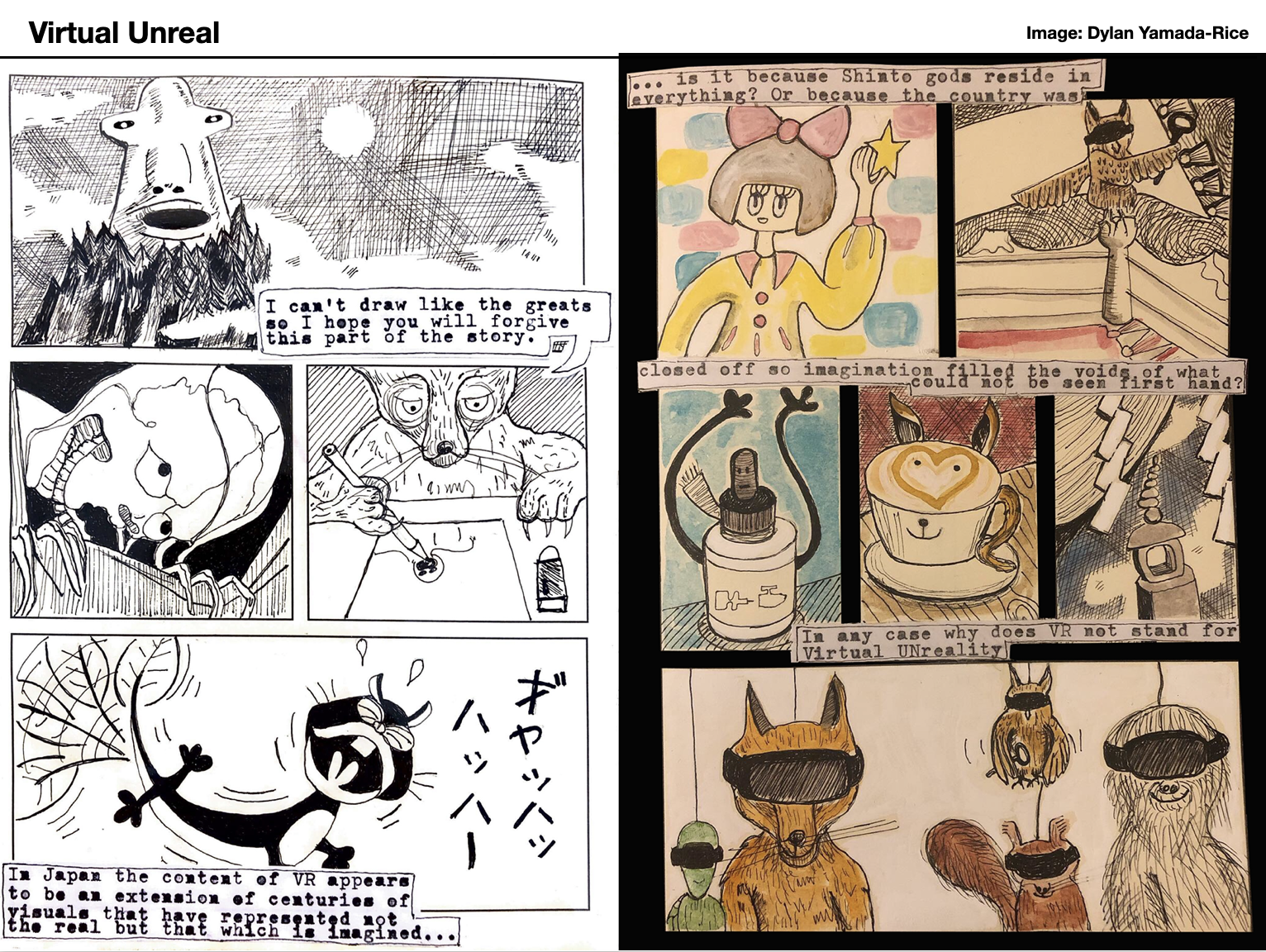
Kids & the Metaverse
Keynote with David Kleeman Cinekids, 15th- 30th October 2021
A talk from within Roblox
Children & VR Panel
| Invited keynote for Bodies, Movement and AI in VR Conference, Goldsmiths, London, 3rd September 2021 |
Children, VR & Magic
Interaction, Design, Children Conference, London June 2021
Digital Devices Before 5
Invited panel presentation for 'Digital Devices Before 5' workshop for Bradford City Council organised by University of Leeds, 10th May 2021
Stories, Flow and Dimensions
In Conversation with Nick Sousanis, MA:UX Symposium,London College of Communication, 6th December 2021
2020
Seeing/ Looking/ Watching
Inspire Talks, University of Tokyo, 29th July 2020

Children & Virtual Reality
Practicing Universal Design Principles in Design Education through a Cad-based Game (PUDCAD) Universal Design Practice Conference: Game + Design Education, Istanbul, 24-26th June 2020

Invited Panelist for Interaction Design Children Conference, London (Delivered online due to Covid-19 restrictions)
2019
Children and Virtual Reality
Keynote for 10th Clash of Realities, 10th International Conference on the Art, Technology and Theory of Digital Games, Cologne Game Lab, TH-Köln, Germany, 19th-21st November, 2019
In this presentation, I will share some of the insights I have gained from undertaking various research projects about children and Virtual Reality. Specifically, I will draw on three studies in this area and share key findings that have specific implications for how we design and think about this technology for younger users.
The first is a commercially funded project, undertaken as part of my work for Dubit a company specialising in strategy, research and development of digital media for children. The study known as the CVR report was undertaken at the dawn of this latest wave of VR, and provides initial insight into how children interact with a range of virtual content on both low and top-end Head Mounted Displays. This study also provides insights into health and safety aspects of using VR with under 12-year-olds. The presentation will then go on show how the CVR study provided some interesting insight into the role of physical materials in children’s virtual play.
This will lead to sharing details of a second project that was part of a large-scale EU study on how children can use makerspaces and Fablabs to create with and for VR. This was a collaborative study with Glück Workshops and Vaikai in Berlin, as part of the wider MakEY project.
Finally, I will share some insights from my most recent AHRC/ ESRC funded network which has been exploring location-based VR experiences for children in the UK and Japan.

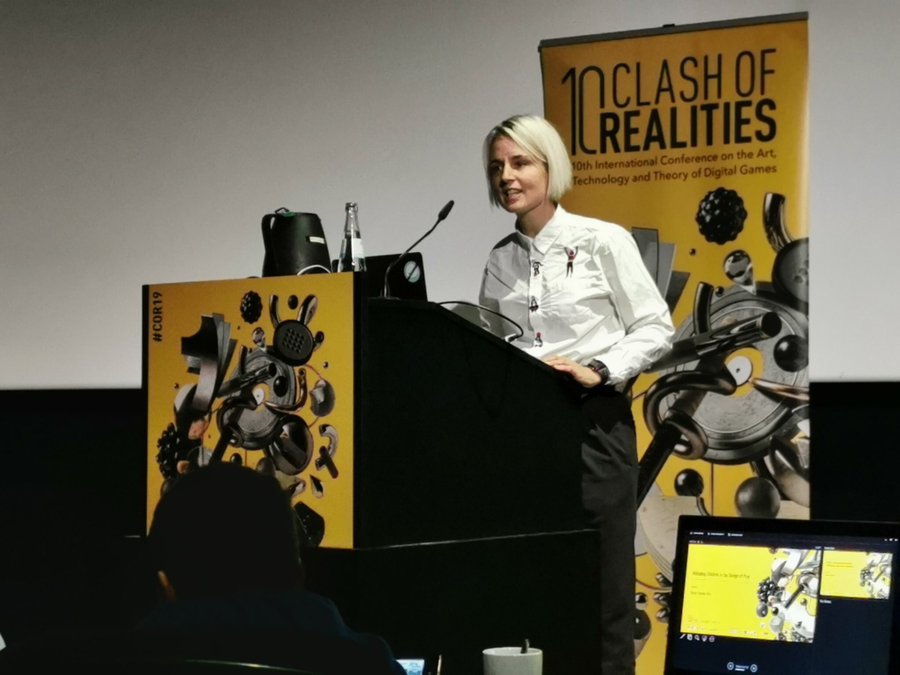
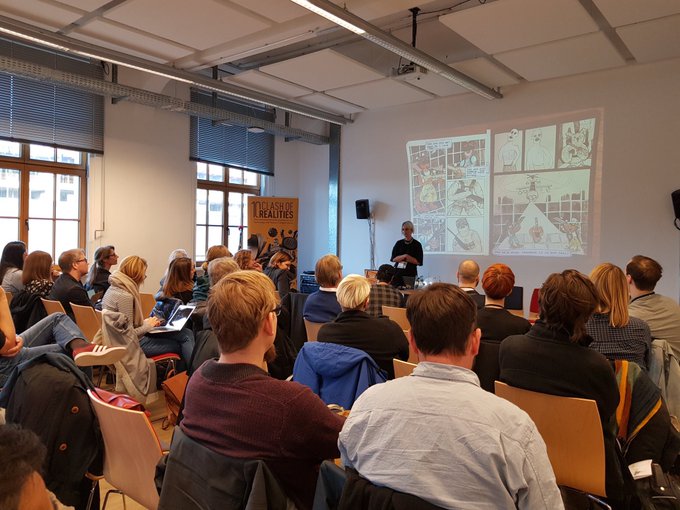
Including Children in the Design of Play
10th Clash of Realities, 10th International Conference on the Art, Technology and Theory of Digital Games, Cologne Game Lab, TH-Köln, Germany, 19th-21st November, 2019
How can design and play-based methods help children feed their ideas into the design of tech products? How can kids and VR research be turned into physical prototypes and products? Dylan provides examples of how research, design and development can marry up well. Her presentation will address ideas around how children’s expertise about their own play interests and digital games designers’ knowhow can be better aligned in the design and development stage of new types of digital play.
“For the tenth time, the Clash of Realities international research conference is providing the opportunity for interdisciplinary exchange and dialogue. Experts from the academy, science and research, economics, politics, and the game industry will discuss pressing questions concerning the artistic design, technological development, and social perception of digital games, as well as the spreading of games literacy.
This conference welcomes scholars, social scientists, game developers, specialists in education and media, up-and-coming creative talents, students, and all those interested in and excited by digital games.
More than 50 international speakers from the academy, science and research, economics, politics and the game industry along with an enthusiastic audience will convene at the Cologne Game Lab, TH Köln – University of Applied Science, a pillar of interdisciplinary exchange and dialogue.
The conference kick-off including the opening keynote will be followed by a day of summits featuring talks, project presentations, panel discussions, and workshops. Finally, the main day of the Clash of Realities will feature renowned speakers from all around the globe.
As part of the tenth anniversary edition, the conference will also host the interactive touring exhibition Games Culture in Germany. Milestones“ by the Computerspielemuseum, which presents a selection of milestones in German games culture.“
Developing a Mixed-Realities Playkit to help children prepare for an MRI Scan without ageneral Anesthetic
Digital Health Technology Catalyst, NEXUS University of Leeds, 9th October 2019

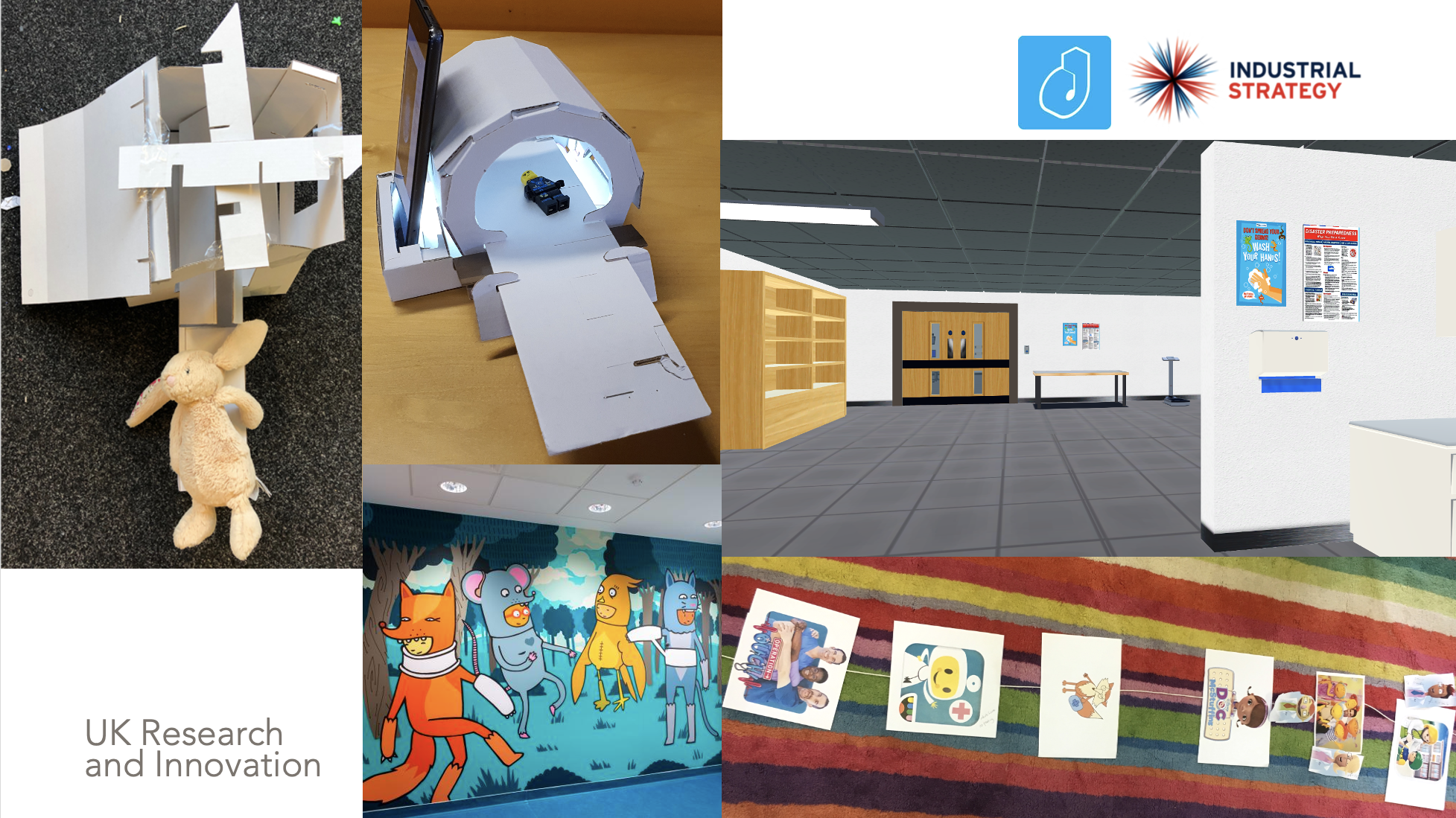
Developing a Mixed-Realities Playkit to help children prepare for an MRI Scan without ageneral Anesthetic
Caring Together Conference, Philadelphia Conference Centre, Sheffield, September 2019
The presentation responded to questions about why the playkit was created, the need it fulfils, why the use of mixed realities technologies and challenges faced during the playkits research and development so far.
Media Medicine
Children’s Media Conference, 4th July 2019
I presented work on the then emerging mixed realities play kit to help children prepare for an MRI scan, as part of a wider panel that looked at the role of media in children’s health. Others on the panel included Alisha (Teddy Bear’s Hospital), Dominic Minns (Plug-in Media), Kez Margrie (CBBC Commissioning Editor, Independents) and it was moderated by Nat Mills (Technologies and Innovation in Child Health)
Kids with Stones in their Pockets
Children’s Media Conference, 4th July 2019
I presented work on my part of the MakEY project looking at children’s interest in physical materials in relation to Virtual Reality. Others on the panel included: Mikkel Lee (Lego) who spoke about what a Creative Story Lead at Lego does. Ash Perrin introduced his work with Flying Seagull. This was followed by a panel discussion that was chaired by Alison Norrington from StoryCentral.
Location-based VR experiences for children
University of Tokyo, 28th June 2019
A presentation for UT-Virtual students at the University of Tokyo as part of our AHRC network project.

Makerspaces and VR
Reconceptualising Early Childhood Literacies: An International Conference, 7th-8th March, 2019
Children and VR: Emerging Possibilities and Challenges
BAFTA, London, 19th September 2018
Reconceptualising Early Childhood Literacies: An International Conference, 7th-8th March, 2019
2018
Children and VR: Emerging Possibilities and Challenges
BAFTA, London, 19th September 2018

Using Information Experience Design and Multimodality to make sense of experiences in physical and virtual curated spaces
9th International Conference on Multimodality, University of Southern Denmark, 15-17 August 2018
This paper demonstrated my use of multimodal theory in relation to the discipline of Information Experience Design (IED) a subject that I was at the time teaching at the Royal College of Art. I demonstrated how the use of multimodality in relation to IED contributes to the development of the multimodal paradigm.
Information Experience Design is a new, hybrid field unrelated to informatics or commercial ‘user experience’ where research is undertaken using theories of information and experience drawn from the social sciences, physics, computer science and communications research (including multimodal social semiotic theory). The discipline is forward thinking centring on multisensory forms of analysis and understanding, that have been made necessary by the proliferation of technologies and the growing capacity to gather data, which has raised questions about how people experience information, and how information is both communicated in and generated from embodied experiences. IED makes use of advances in digital technologies, combined with analogue making to produce a range of multimodal data that is then analysed in order to design means for people to experience data in innovative ways such as through physical-digital installations.
After outlining IED, I drew on my interest in virtual spaces to show how I have combined multimodality with hands-on methods of drawing, animation and making to inform changes in the digital games industry. To do so I drew on examples from a commercially-funded study on children’s interaction and engagement with a wide range of virtual reality content and devices.
Connected toys & social robots: what measures are in place to assist but equally protect your kids?
With Stéphane Chaudron (European Commission), Jackie Marsh (University of Sheffield) and Giovanna Mascheroni (Università Cattolica del Sacro Cuore)
ESOF, 9th-14th July, Toulouse
In this the 1 hour and 15 minutes Pecha Kucha session, we presented visual stories about the safety, security, privacy and societal questions emerging from the rise of the Internet of Toys:
-
Stéphane Chaudron: The rise of The Internet of Toys & safety and security considerations (with concrete illustrations of cases)
-
Giovanna Mascheroni : The Internet of Things and the Quantified Child
-
Jackie Marsh: The Internet of Toys and the Changing Nature of Play
-
Dylan Yamada-Rice: Designing connected play - Perspectives from combining industry and academic knowhow

Children’s Media Conference, Sheffield, 4th & 5th July, 2018
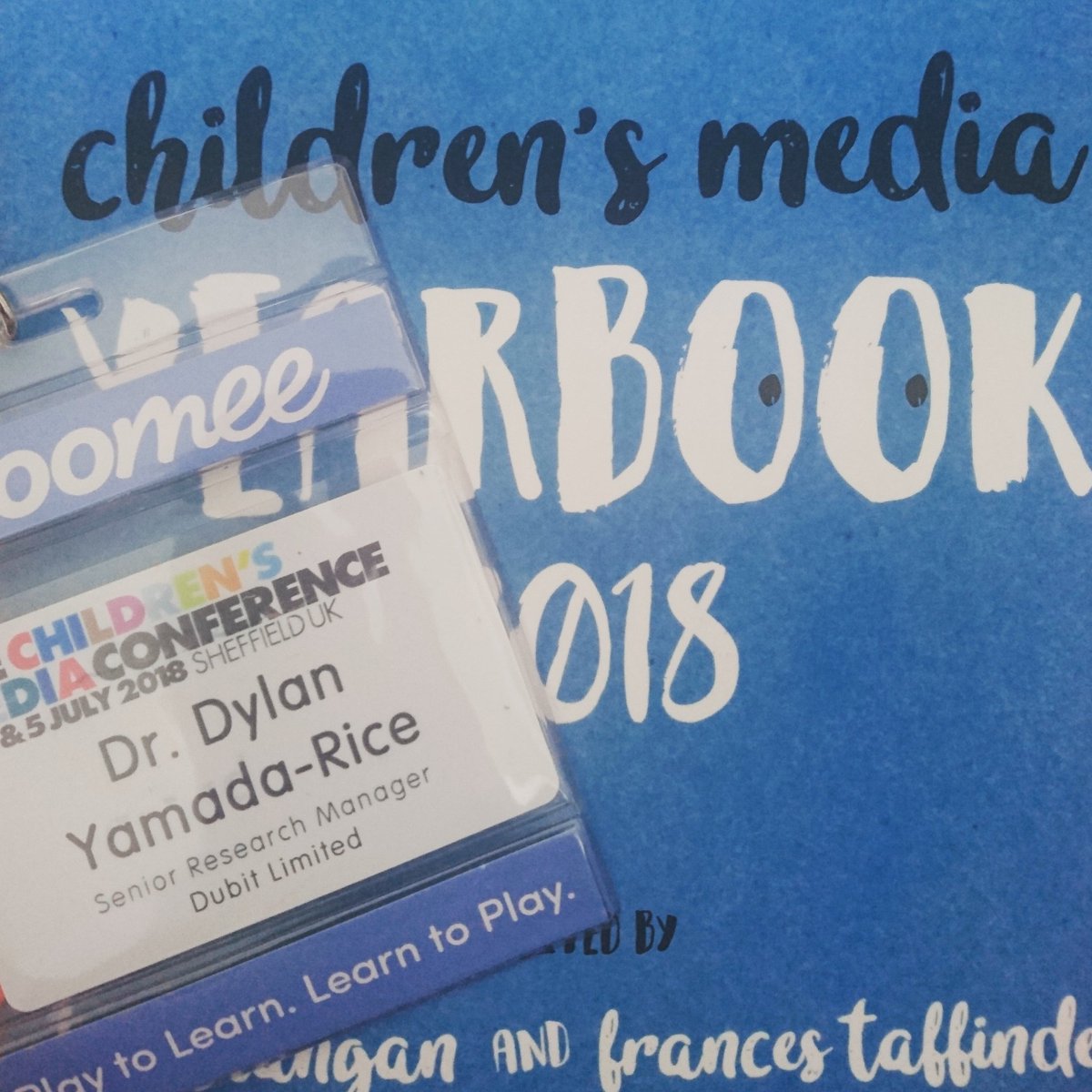
Kids Regio Berlinale, Berlin, 17th Feburary 2018
I was part of a panel on New Realities - New Worlds, VR Experiences for Children’s films with Alison Norrington (Storycentral, UK) and Rafael Pavon (Future Lighthouse, Spain). We addressed the following topics: Where the objective is of VR for children’s media? How children interact with Virtual Reality? The impact of VR on children and how safe it is. My part specfically addressed the following:
Children and VR
Chaired by Alice Web (BBC)
Children’s Global Media Summit, 5-7th December 2017
I was part of a panel on New Realities - New Worlds, VR Experiences for Children’s films with Alison Norrington (Storycentral, UK) and Rafael Pavon (Future Lighthouse, Spain). We addressed the following topics: Where the objective is of VR for children’s media? How children interact with Virtual Reality? The impact of VR on children and how safe it is. My part specfically addressed the following:
-
Impact and extent of my research for Dubit on VR & children
-
Health concerns around VR & children – ophthalmic, sensory & cognitive overload, addiction, immersion.
-
Best practices for good content for children
-
Onboarding children into VR experiences
-
Benefits and best practices of VR experiences for children
2017
Children and VR
Chaired by Alice Web (BBC)
Children’s Global Media Summit, 5-7th December 2017
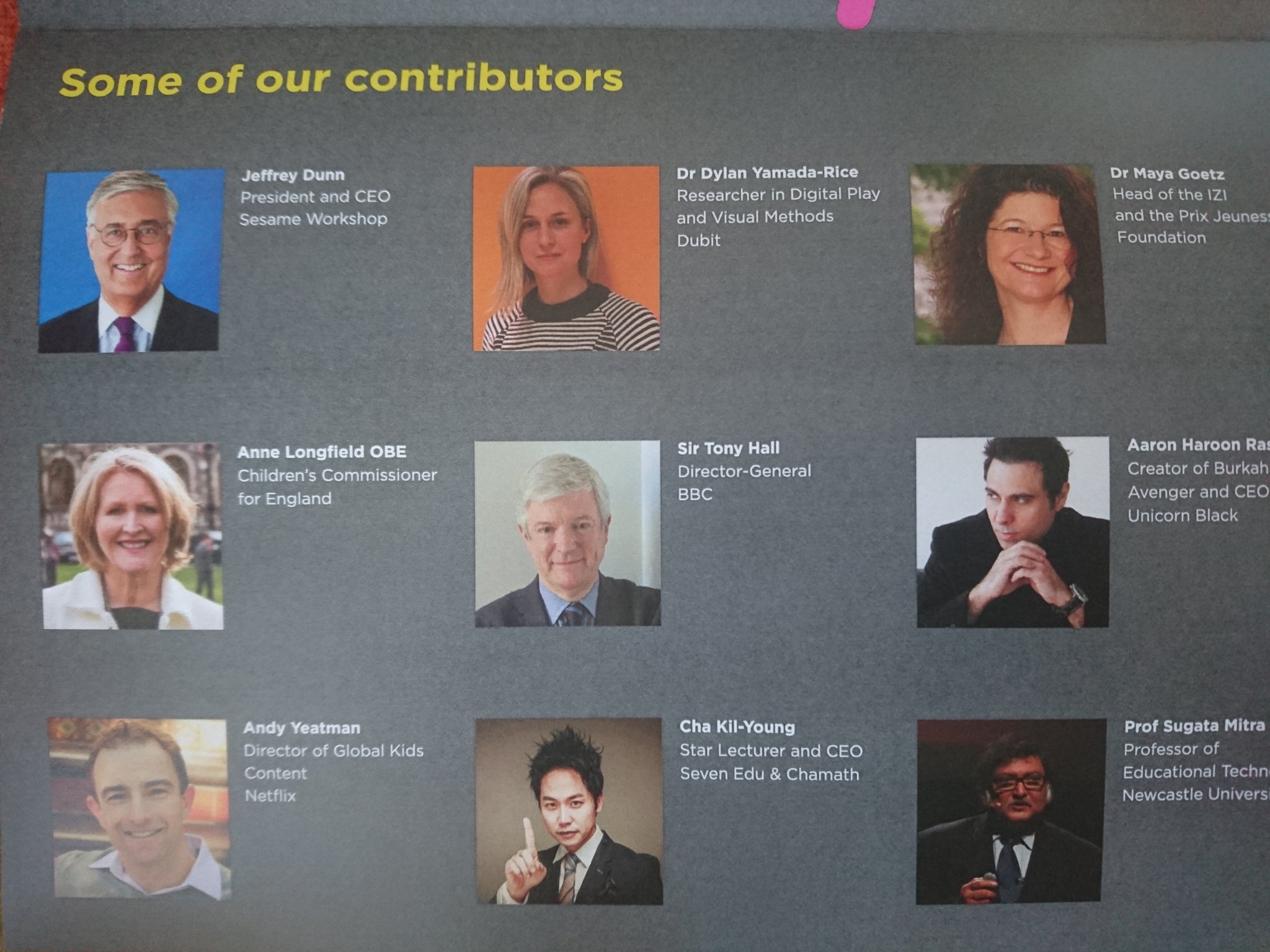
Children & Virtual Reality: Interaction/ Engagement/ Health & Safety
DigilitEY, Bolgona, Italy 30th August- 1st September. 2017
Information Experience Design
A Centre for Multimodal Communication Seminar, University of Southern Denmark, 27th October, 2017
In this talk I introduced the reletively new discipline of Information Experience Design (IED). IED is an approach to research that is about transforming information into experiences through the pathways of Sounde Design, Moving Image Desing and Experimental Design, encompassing data visualisation and narrative, installations and exhibitions research and investigative design. The talk provided an overview of IED and shows how work in this field takes from the spectrum of fine art, machine learning and design, as well as, the social sciences to understand data and create experiences that represent it in multimodal and experimental ways.
VR and Architecture
Oslo, Norway, 8th August, 2017
Pop-up Makerspace
With Jackie Marsh (University of Sheffield) and Deborah Rodrigues Moreira (Glück Workshops, Berlin)
Valuing the Visual in Literacy Research, International Conference, The Edge, University of Sheffield, 4th-5th July, 2017
What are makerspaces? How can they be relevant to literacy learning? Come along to a pop-up makerspace and find out! Try your hand at DIY art, craft, robotics and electronics and join in our reflections on how this can inform literacy learning and teaching.
The Ethics of VR: Inside a Child’s Virtual World
Children’s Media Conference, 4-6th July, 2017
I was an invited panalist chaired by Christine Colbeck (Entertainment One). Other panalists included Stuart Dredge (Articulates TV), Marc Goodchild (Turner) and Mark Mon-Williams (University of Leeds),
Areas discussed by the panel included:
• Best practices
• Is it too early for policy/regulation – do we need more creative first?
• Would external regulation/policy inhibit innovation?
• How do we regulate VR use by children?
• What should be industry standards for VR?
• Immersion & addiction: the fine line of balance?
• Research into the use of VR HMD’s for children under 13?
• Short term physical side effects: ophthalmic, motion-sickness, physical accidents
• Long term neurological impact (potentially connected to over-immersion, cognitive overload, disruption of neuro-spacial mapping during formative years) - content moderated before it reaches the child?
Children and Virtual Reality
Dubit, 25th April 2017
This was a joint event between Dubit and the University of Sheffield. The morning focused on VR and Narrative, and the afternoon on VR and Education. The event was held as an invitation only event to distribute the Children and VR research report. In attendance were a mix of academic and industry delegates.
11am - Welcome, and introduction to panel topics
Dylan Yamada-Rice, Dubit & Jackie Marsh, on behalf of the COST Network
11:15am - 11.30 VR Devices and Distribution
Bobby Thandi, Dubit
11.30- 12.30pm -VR and Narrative Panel
Wendy Harris, Tutti Frutti
Dylan Yamada-Rice, Dubit
Anna Riddler, Royal College of Art
Sparks Videos of Industry professionals ideas and questions
12.30-1pm Q & A chaired by Jackie Marsh, University of Sheffield
1.30- 2.30pm VR and Education Panel
Jackie Marsh, University of Sheffield
Deborah, Gluck Workshops, Berlin
Becky Parry, University of Nottingham
2.30-3pm Q & A chaired by Dylan Yamada-Rice, Dubit
3-3.15 Plenary Jackie Marsh
3.15- 3.45 VR Demonstrations
Dubit
VR Narratives for Children
The Hub, YouTube Space, London, 9th March, 2017
DigilitEY, Bolgona, Italy 30th August- 1st September. 2017
Information Experience Design
A Centre for Multimodal Communication Seminar, University of Southern Denmark, 27th October, 2017
In this talk I introduced the reletively new discipline of Information Experience Design (IED). IED is an approach to research that is about transforming information into experiences through the pathways of Sounde Design, Moving Image Desing and Experimental Design, encompassing data visualisation and narrative, installations and exhibitions research and investigative design. The talk provided an overview of IED and shows how work in this field takes from the spectrum of fine art, machine learning and design, as well as, the social sciences to understand data and create experiences that represent it in multimodal and experimental ways.
VR and Architecture
Oslo, Norway, 8th August, 2017
Pop-up Makerspace
With Jackie Marsh (University of Sheffield) and Deborah Rodrigues Moreira (Glück Workshops, Berlin)
Valuing the Visual in Literacy Research, International Conference, The Edge, University of Sheffield, 4th-5th July, 2017
What are makerspaces? How can they be relevant to literacy learning? Come along to a pop-up makerspace and find out! Try your hand at DIY art, craft, robotics and electronics and join in our reflections on how this can inform literacy learning and teaching.
The Ethics of VR: Inside a Child’s Virtual World
Children’s Media Conference, 4-6th July, 2017
I was an invited panalist chaired by Christine Colbeck (Entertainment One). Other panalists included Stuart Dredge (Articulates TV), Marc Goodchild (Turner) and Mark Mon-Williams (University of Leeds),
Areas discussed by the panel included:
• Best practices
• Is it too early for policy/regulation – do we need more creative first?
• Would external regulation/policy inhibit innovation?
• How do we regulate VR use by children?
• What should be industry standards for VR?
• Immersion & addiction: the fine line of balance?
• Research into the use of VR HMD’s for children under 13?
• Short term physical side effects: ophthalmic, motion-sickness, physical accidents
• Long term neurological impact (potentially connected to over-immersion, cognitive overload, disruption of neuro-spacial mapping during formative years) - content moderated before it reaches the child?
Children and Virtual Reality
Dubit, 25th April 2017
This was a joint event between Dubit and the University of Sheffield. The morning focused on VR and Narrative, and the afternoon on VR and Education. The event was held as an invitation only event to distribute the Children and VR research report. In attendance were a mix of academic and industry delegates.
11am - Welcome, and introduction to panel topics
Dylan Yamada-Rice, Dubit & Jackie Marsh, on behalf of the COST Network
11:15am - 11.30 VR Devices and Distribution
Bobby Thandi, Dubit
11.30- 12.30pm -VR and Narrative Panel
Wendy Harris, Tutti Frutti
Dylan Yamada-Rice, Dubit
Anna Riddler, Royal College of Art
Sparks Videos of Industry professionals ideas and questions
12.30-1pm Q & A chaired by Jackie Marsh, University of Sheffield
1.30- 2.30pm VR and Education Panel
Jackie Marsh, University of Sheffield
Deborah, Gluck Workshops, Berlin
Becky Parry, University of Nottingham
2.30-3pm Q & A chaired by Dylan Yamada-Rice, Dubit
3-3.15 Plenary Jackie Marsh
3.15- 3.45 VR Demonstrations
Dubit
VR Narratives for Children
The Hub, YouTube Space, London, 9th March, 2017
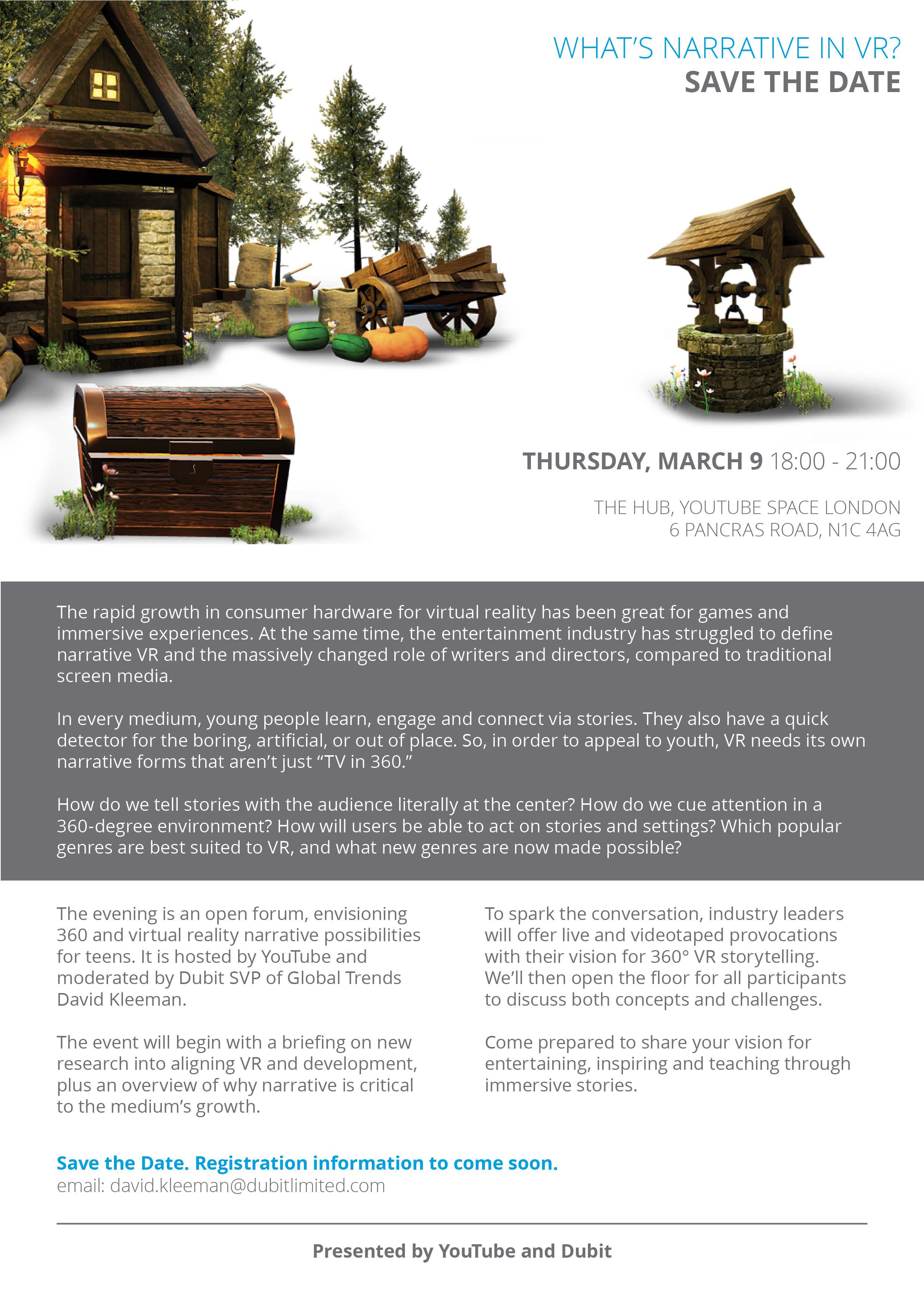
2016
Designing Play: Young Children’s play in relation to Designers Intentions for their toy
Sheffield Hallam University, 15th December, 2016
This talk will focus on the findings of a Short Temr Scientific Mission funded by the COST-network DigiLitEY. The project focused on a new type of screen-less physical-digital toy known as Avakai. The toy was considered in relation to designers’ intentions and children’s use. The findings are described in relation to play and communication practices and center on theories of new materialism and object-ethnography.
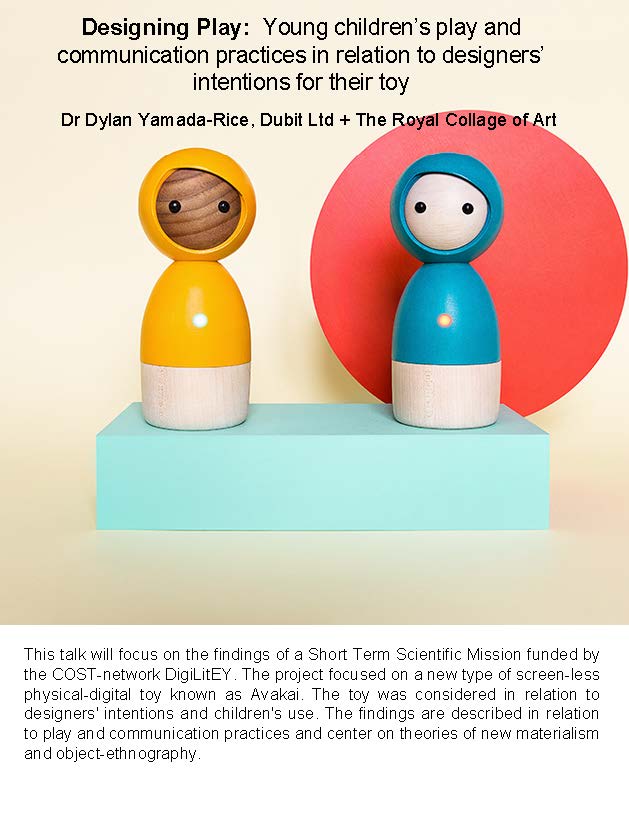
Designing Play: young children’s play and communication practices
University of Edinburgh, 27th October 2016
This talk focused on the findings of a Short Term Scientific Mission funded by the COST-network DigiLitEY. The project focused on a then new type of screen-less physical-digital toy known as Avakai made by Vai Kai in Berlin. The toy was considered in relation to designers' intentions and children's use. The findings were described in relation to play and communication practices and center on theories of new materialism and object-ethnography.
Presentation and workshop on multimodal theory and research
GW4, Universities Research Training on Multimodal Methodologies in Education, University of Bath
Innovations and Connections in Visual Research
White Rose Doctoral Training Centre Fifth Annual Conference
Report on the Tech and Play Project: children’s use of apps for play and creativity
Literacy Trust Talk to your Baby Conference, London, 29th Feburary, 2016
2015
Young Children’s Interaction with and Comprehension of Images in their Environments
British Education Research Association Conference, Belfast, Ireland, 15th - 17th September, 2015
Visual Methods, Objects and Material Culture in Early Childhood
British Education Research Association Conference, Belfast, Ireland, 15th - 17th September, 2015
Workshop given with Lisa Procter.
This session feel within a panel called “Innovation Sessions” and took the form of a workshop/masterclass in researching early childhood using visual methodologies, combining presentations, graffiti and Information Experience Design technique in innovative ways. The aims were:
-to consider Visual Methods for exploring, analyzing and representing different forms of data, specifically researching with and through objects
-to explore theories of the dialectical relationship between objects and material cultur (Miller, 2009; Procter, 2013) and to experience different methods for exploring the everyday in innovative ways .
This session drew on several research projects led by members of th Centre for Research in Early Childhood Education at the University of Sheffield, who at the time were combining Social Sciences and Arts-base methodologies in innovative ways. In relation to this we used a selection of objects to explore how these were located in material cultures, what narrative they represented, and what the implications for portraying change were over time. The narratives drew on themes that were personal, temporal, cultural and emotional. Each 'object' was framed as more than its tangible form: as a symbol, a concept (or constellation of concepts), a narrative, a history, a personal/cultural memory trail. The object was seen to represent emotion/s, in tangible/intangible forms, in ways that revealed how identities are constructed through engagement, participation and resistance inside and outside material cultures.
A head of participants exploring these ideas in relation to their own objects, we demonstrated these in relation to objects from our own research, for example I used a wooden block and the Minecraft App to symbolise change and continuities in traditional and digital play. Whilst Lisa used a Tamagotchi (a handheld digital pet) to consider children' emotional relationships with the material world and their identity. Combined, these everyday objects of childhood acted as provocations to consider the ways in which children are positioned in research, whether visual methods can promote authentic participation, how material cultures carry images and discourses about children and childhood, and about early childhood education, what they reveal about change and continuities over time.
Young children's interaction with and comprehension of images in relation to their emerging multimodal communication practices
United Kingdom Literacy Association, University of Nottingham, 10th July, 2015
Here I presented the findings of a study that had the notion of ‘Re-assessing Literacy in the 21st Century’ at its heart. The project considered the impact of increasingly visual means of communicating (due to evolving digital media) on children’s emerging knowledge of communication practices. It focused on seven 3 to 6-year-olds interaction with, and comprehension of images across six months in Japan. Data were collected using children’s photographs of their interest in images, video recordings of environmental walks, interviews and mapping. They were analysed using content analysis, stop-motion animation and thematic analysis. The data illustrates how children primarily make meaning of images through their knowledge of and interest in the physical world. It also shows how some of their image comprehension is emerging through interest in fictional visual texts such as comics, animation and gaming. The findings add to research on emerging literacy and its connection to environmental print, to illustrate how interaction with images adds not only to children’s developing understanding of literacy but more broadly to their knowledge of multimodal communication practices. This is important because the continuing development of digital media means the visual mode is increasingly foregrounded in multimodal communication practices.
Symposium: ‘Literacy and learning with tablet apps’.
United Kingdom Literacy Association, University of Nottingham, 10th July 2015
Presentation given with Jackie Marsh.
Play in Dark Times
Dark Play in the Digital Arts, Middlesex University, 6th-7th July, 2015
Digital literacies for Hospital Spaces
Everyday Language, Everyday Literacy Conference, University of Sheffield, 27th June, 2014
Reconceptualising data: visual and multimodal methodologies.
EERA Summer School, University of Sheffield, UK, 25th June, 2015
Presentation with Caroline Claisse, and Xinglin Sun on the methods used as part of our AHRC network on videogames for hospitalised children.
In this seminar we explored different ways of making the visual the mode of enquiry, the form of analysis and the means of data (re)presentation. We made a distinction between visual methods as a ‘catch-all’ label to define established approaches such as video and still images, drawings, sculptures and models that are used across a range of disciplines. Instead, we showed how visual methodologies make the visual the mode of enquiry, the form of analysis and the means of data (re)presentation, and can encompass movement, gestures, dance, drama, musicality. In terms of personal meanings, memories and experiences, the visual may be sensory, symbolic, metaphoric and existential, and one person’s response and interpretation may differ from another’s, even to the same event, image or memory.
The session was organised in two parts: first a whole group sessionintroduced participants to visual methods in research. This drew on the work of us as presenters, specifically in combining Visual Methods with Information Experience Design. We exemplified the potential benefits and the challenges of doing visual research through recent projects Second, we split into three groups for a practical workshop 'Tangible Emotion' that focused on representing emotions.
Following the workshop, we reflected on some key questions:
-How can visual methodologies find a place alongside established research paradigms?
-Where do visual methodologies work best, or work differently from other qualitative methods?
-How can the visual and the verbal create new ways to tell significant stories about people’s lives and experiences, including diverse ways of knowing and being?
-How do we ensure that visual methods are culturally responsible, and culturally anchored?
-What ethical considerations should come to the fore when using visual methods?
-How can we sustain ethical relationships with research participants when using visual methods?
-What forms of power are created in using digital tools and methods in visual research?
The Importance of Supporting Young Children’s Digital Literacies
Invited Keynote, Asian Festival of Children’s Content, Singapore, 30th May, 2015
Visual technologies and well-being: designing videogames for hospitalised children
Centre for Visual Studies training on Visual Methods
2014
Emotions in a Networked Society: How is the digital shaping emotional engagements with cities across different generations of people
7th International Conference of Multimodality (7-ICOM), Hong Kong Polytechnic University, 11th- 13th July 2014
Considering the role of culture in multimodal language theories
Multimodality in Language Research, University of Leeds, 25th June, 2014.
Hospital Heights
Games Talk, W00t Games Festival, Copenhagen, 30th May- 1st June 2014
Hospital Heights a board game developed as part of the AHRC videogames network project at Board Game Galore-track. Also presented on the project as part of the Games Talk part of the Festival, W00t Play Festival, Copenhagen, 05/14
The Play Festival offered a context for testing Hospital Heights:
Considering the role of culture in multimodal language theories
Multimodality in Language Research, University of Leeds, 25th June, 2014.
Hospital Heights
Games Talk, W00t Games Festival, Copenhagen, 30th May- 1st June 2014
Hospital Heights a board game developed as part of the AHRC videogames network project at Board Game Galore-track. Also presented on the project as part of the Games Talk part of the Festival, W00t Play Festival, Copenhagen, 05/14
The Play Festival offered a context for testing Hospital Heights:

Mapping layers of current multimodal and future post-human, postdigital future
RCA Symposium on Mapping Post-digital futures, Royal College of Art, London, 2nd May, 2014
Designing Play for Hospitalised Children
AHRC Showcase, London, 12th March 2014
Digital play for children in hospital and recovery spaces
Faculty of Social Sciences Conference, University of Sheffield, 19th September, 2014
2013
Defacing Visual Artefacts to Explore Ways of Disseminating Research Findings to Children
Qualiatative Ethnographic Research Network: Sharing and shaping pedagogies – learning through doing. Department of Drama, University of Exeter, UK, 10th May 2013.
Presented with Lisa Procte. Despite widespread interest in visual means of data collection and the use of digital technology in research, there is scope for further exploration of how visual materials could be used in the dissemination of research findings. Therefore this workshop provides an overview of three studies, where digital visual means were embedded in data collection. This is followed by a practical session in which participants will join one of three groups to look at the different potentials of pop-up books, maps and choose you own adventure gamebooks for the dissemination of research. The workshop participants will add new layers/ deface existing examples of these three digital visual media in order to represent the three studies.
An Enquiry into Young Children’s Interaction with and Comprehension of Images in Japan.
Qualiatative Ethnographic Research Network: Sharing and shaping pedagogies – learning through doing. Department of Drama, University of Exeter, UK, 10th May 2013.
Developing Videogames and Play for Hospitalised Children
AHRC Videogames Research Network, AHRC Showcase, London, UK.
Keep Taking the Tablets: Children’s use of Story apps
Children’s Media Conference, Sheffield Showroom, 2013
Qualiatative Ethnographic Research Network: Sharing and shaping pedagogies – learning through doing. Department of Drama, University of Exeter, UK, 10th May 2013.
Developing Videogames and Play for Hospitalised Children
AHRC Videogames Research Network, AHRC Showcase, London, UK.
Keep Taking the Tablets: Children’s use of Story apps
Children’s Media Conference, Sheffield Showroom, 2013
2012
Conveying the Tohoku Earthquake: an Illustration of Japanese Codes and Conventions of the Visual Mode in TV Coverage of a Natural Disaster
6th International Conference on Multimodality, Institute of Education, London, 22nd August, 2012
On 11th March at 2:46pm the building in which I was transcribing research data, was hit by what became known as ‘The 2011 off the Pacific Coast of Tohoku Earthquake’. This was a magnitude 9 reverse-fault, mega-trust earthquake, which triggered a devastating tsunami. The tsunami crippled the Fukushima Daiichi nuclear power plant causing a maximum level 7 nuclear disaster. During the following months I experienced food, water, petrol and electricity shortages as well as hundreds of aftershocks at magnitude 5 or greater. TV coverage became a vital way of keeping abreast of the evolving situation and remaining safe through televised evacuation warnings. Preoccupied in this way I began recording the television coverage of the disaster and related social advertisements. When analysed these present strong examples of the unique cultural affordances of the visual mode and its connection to the written mode, space and place in broadcasted multimodal texts.
The TV footage will be used to illustrate conventions of the Japanese visual mode that appear in televised multimodal texts. These are spatiality, layering, emotional representation and hierarchical relationships between producer and interpreter of texts that are also found in Japanese language patterns. In addition the session will consider how the unique properties of these conventions facilitate messages that need to be disseminated urgently in a disaster situation. Discussion of these cultural conventions of modal use will be linked by the common thread of texts that have derived from coverage of the triple disaster. However, they will also be related to wider cultural practices to illustrate the deep-rooted links between culture, language and modal affordances. In this way it is hoped that the examples given will highlight well how ‘modes carry meanings of material affordance shaped by generations of the work of people in their social lives. Over time this gives rise to a resource with regularities shaped by ‘convention’, understood by members of a culture, and useable therefore by them for representation and communication’ (Kress & Jewitt 2003, p.13/4). In relation to this the session puts forward an argument for greater need to deepen understanding of culturally specific semiotic practices. As the TV texts are visual mode dominant, like Oyama (2000) I contest the notion that the visual mode is a transparent means of communication. The Japanese data presented will be used to illustrate how different cultures have culturally specific affordances of modal use, and that this relates to a culture’s underlying value system.
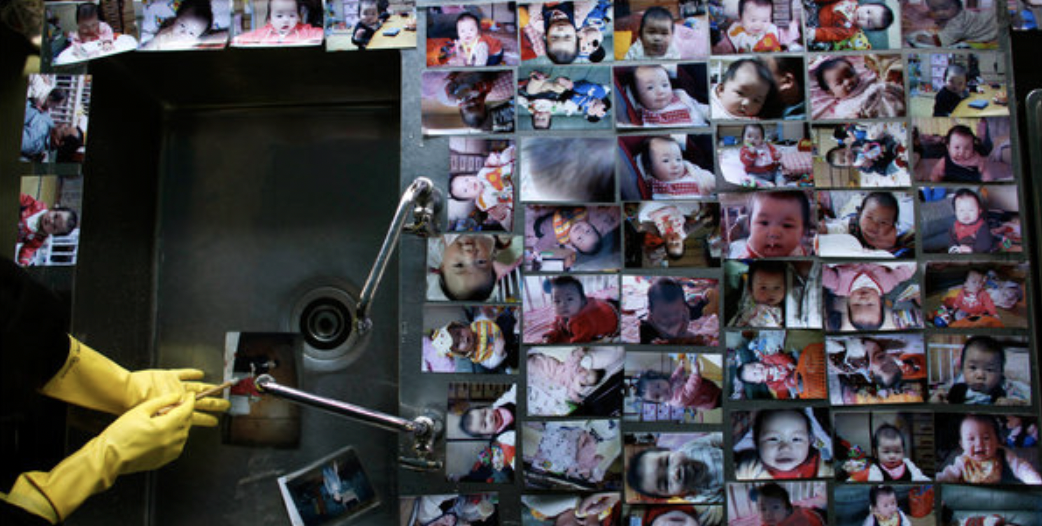
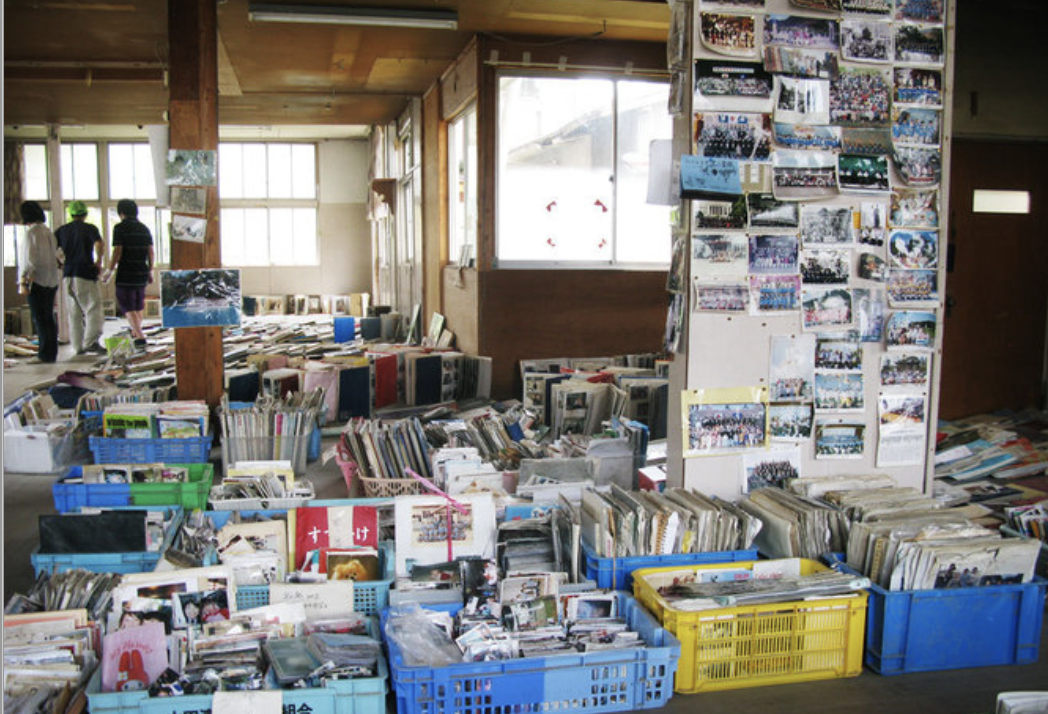


2011
Tentative Thoughts on the Future of Multimodal Data Collection and Analysis
Analysing Multimodal Discourse Seminar Lancaster University
Reflecting upon Research with Children and Young People
Children, Young People and Research as part of the ESRC Festival of Social Sciences, University of Sheffield, 23rd November, 2011
In this workshop children, young people and adults will together create an art- piece to be exhibited after the event. Through creating this art-piece participants will reflect upon how best to involve children and young people in education research, what can be learned from doing so and how this research can be used to benefit education.
This installation was made during an event hosted by the School of Education as part of the ESRC Festival of Social Sciences. Educational researchers and young research participants constructed the structureas they reflected on how best to involve children and young people in research.The structure was created to represent the research process.Research can be seen as a way of creating a fresh perspective to understand better something familiar or unknown.In this way the old boxes become a representation of something new. It is still clear that they are boxes but yet they can be seen in a new lightand thought about in adifferent way. Each of the three colours in thestructure represents the‘voice’ of different groups; Yellow for primary school-aged children, Blue for secondary school-aged young people and Orange for adults. Each box represents an individual or a smaller group within these largerthree categories. Everyone was asked to draw or write on as many boxes as they liked,their views on certain aspects of research with children and young people and add it to the structure any how they wished.The combining of many voices to create one sculpture relates to the successful triangulation of participants in research. The freeform structure relates to the need to allow participants an element of self-direction inresearch. Finally, the blank boxes are a representation of the need to value what children and young people choose not to share in a research project as much as what they do
2010
Visual Aspects of Contemporary Multimodality: an Enquiry into Young Children’s Interaction with and Comprehension of the Visual Mode in Japan
46th UKLA International Conference, University of Winchester, 10th July, 2010
My previous postgraduate research on young children’s use and access to primarily visually-based media in communication practices in Japan (2007) found some differences between Japanese children and their ‘Western’ contemporaries. Young Japanese children were using a wider range of primarily visually-based media with greater frequency. In relation to these findings I came to consider the ‘visual-ness’ of Japanese society in comparison to the UK. Building on theories of ‘Geosemiotics’: ‘the study of the social meaning of the material placement of signs and discourses and of our actions in the material world’ (Scollen & Scollen 2003) my next postgraduate research project (2009) considered differences in the variance and quantity of visuals and their relationship to the written mode in the urban landscapes of Tokyo and London, using Google Street View to make comparisons. The data were analysed using Visual Content Analysis and colour coding. It found Tokyo to have a higher density and diversity of visuals at a wider range of heights. Visual and written communication also appear to be confined to more separately definable spaces with more equal weighting in the use of written and visual modes. Particularly, within the context of early childhood education it is hoped these findings will increase knowledge on young children’s exposure to the visual mode, initiate wider discourse around this lesser researched mode’s role within contemporary multimodal communication practices and that the methodology furthers understanding of the potential of new media in image-based research.
